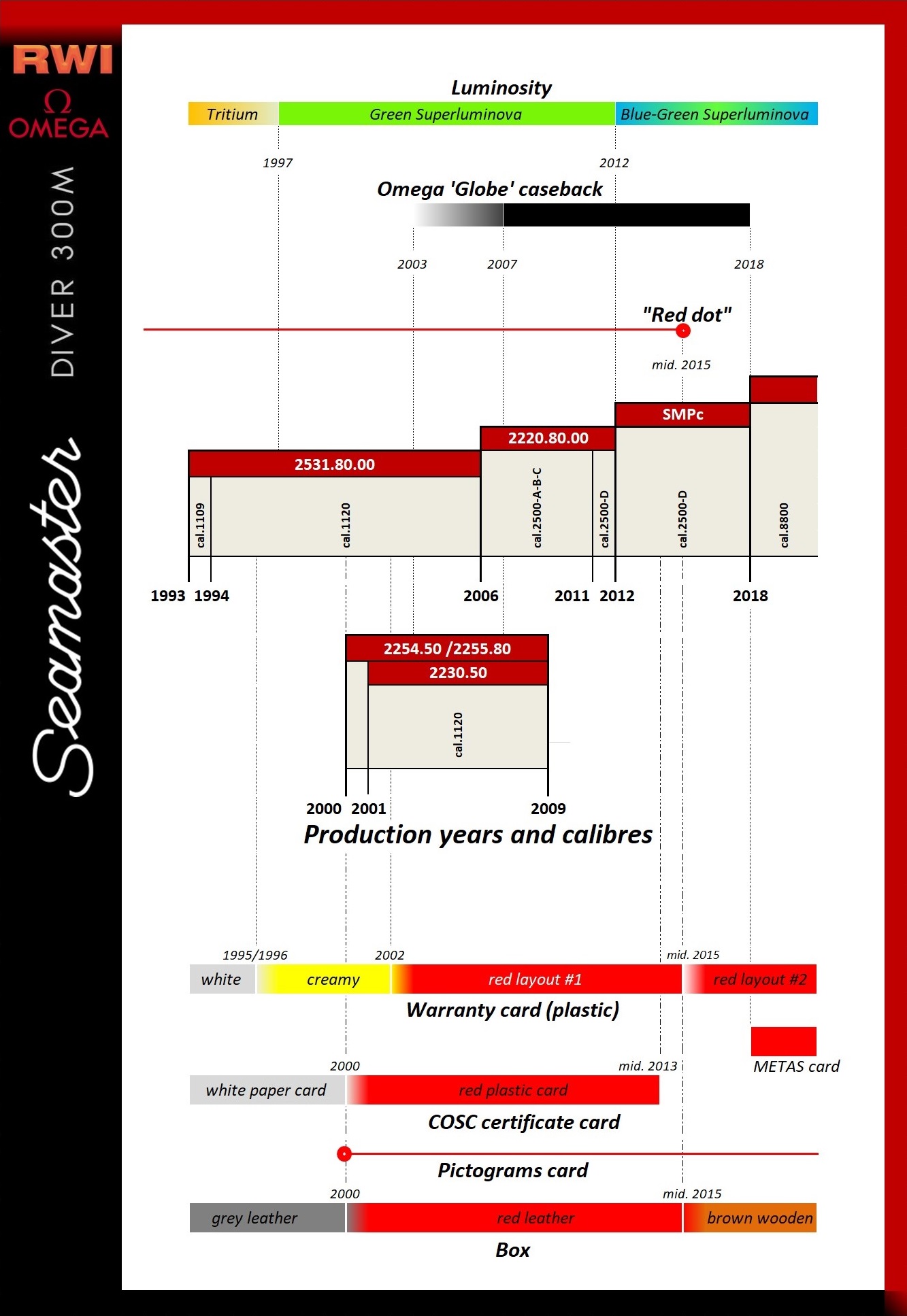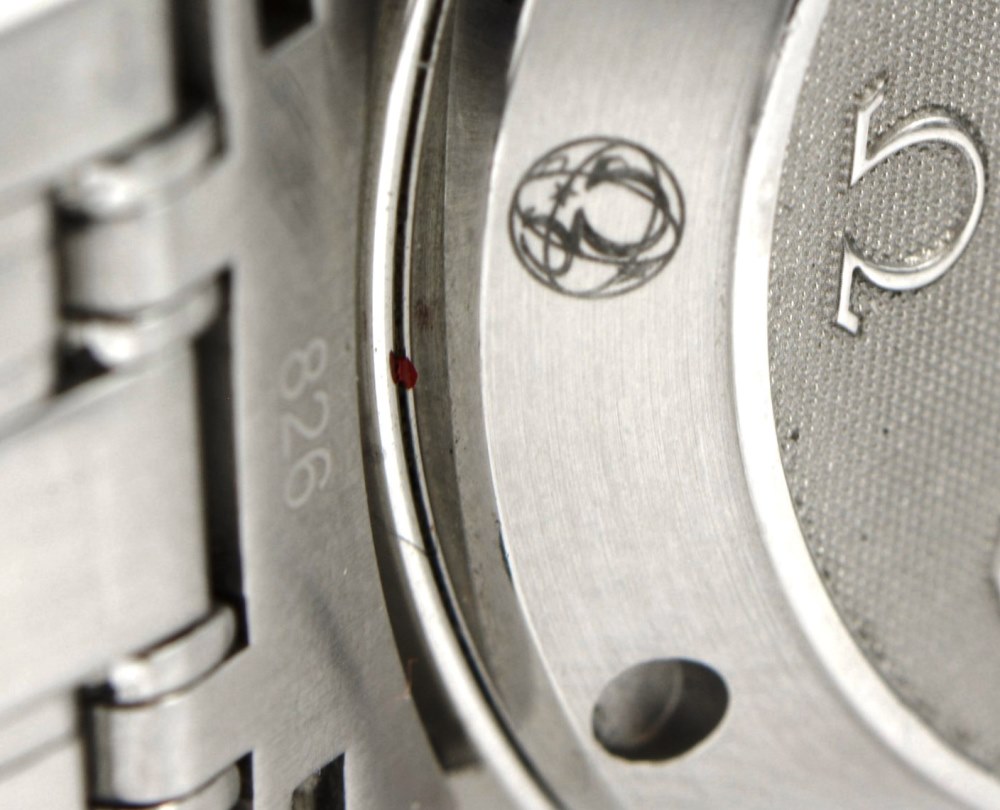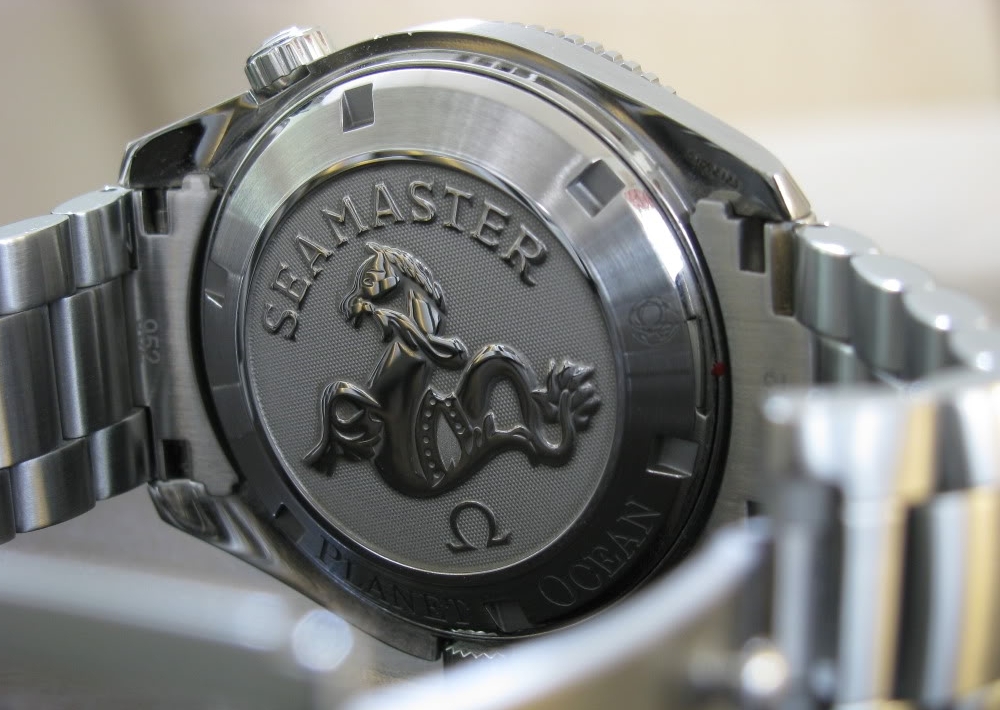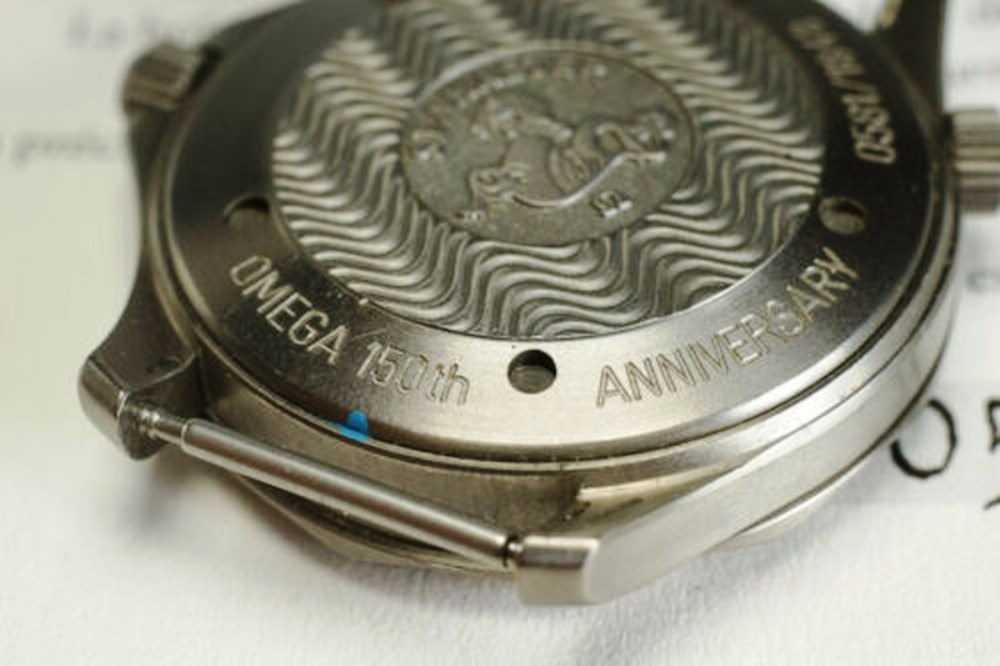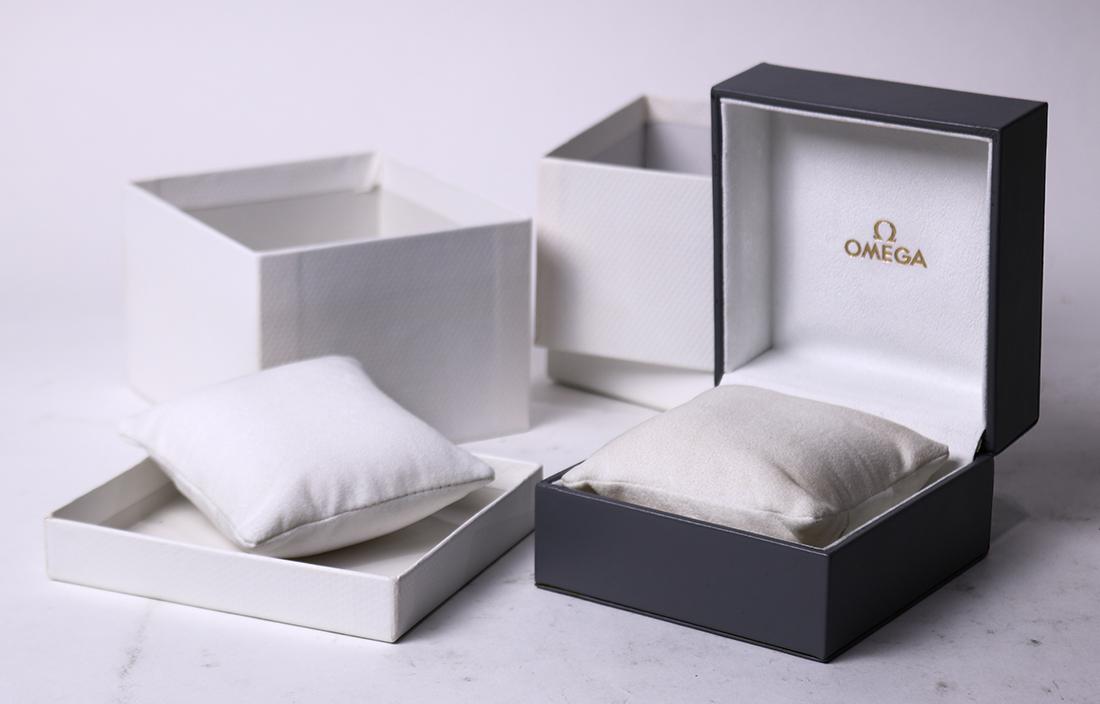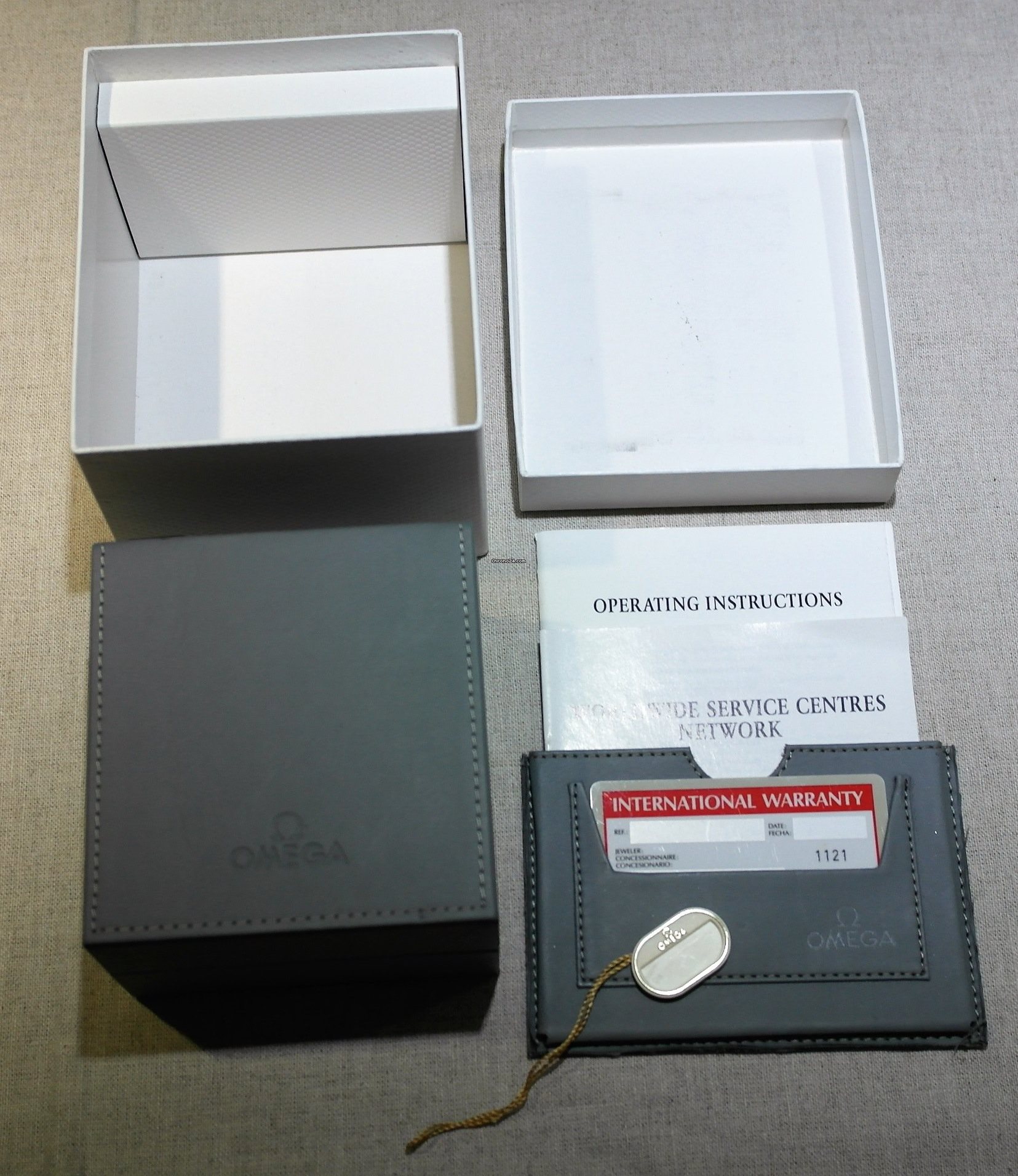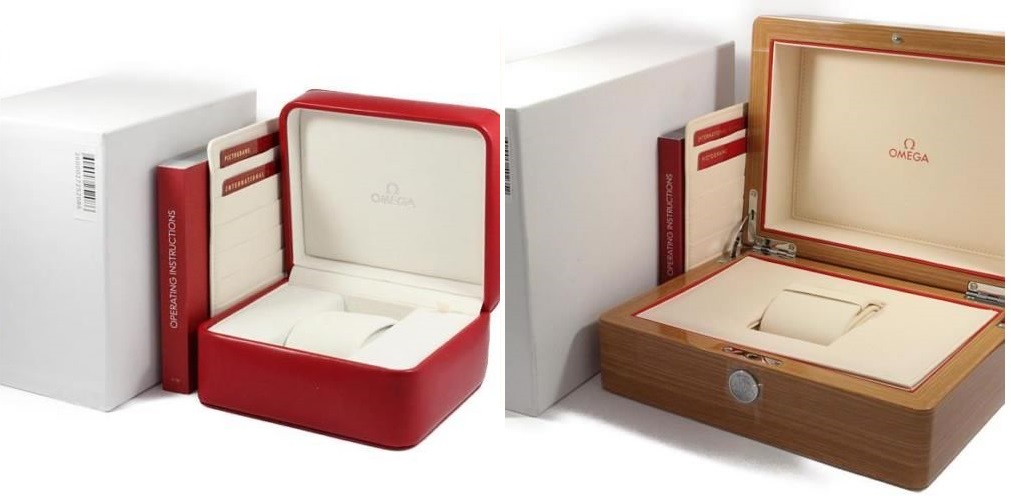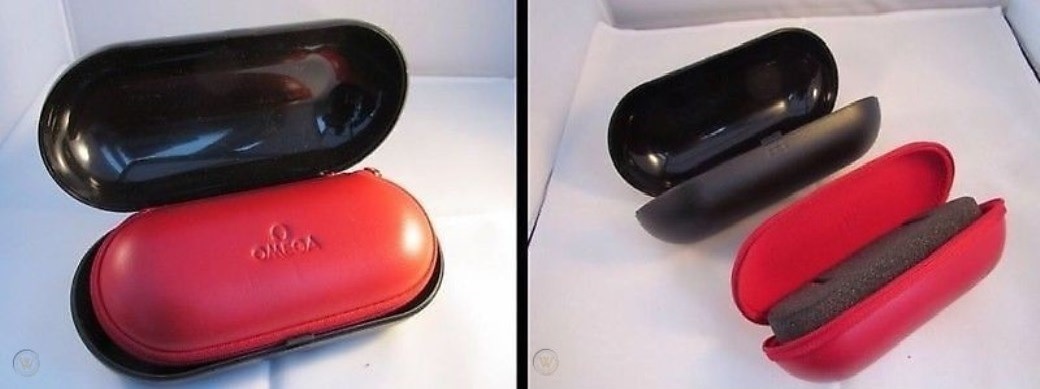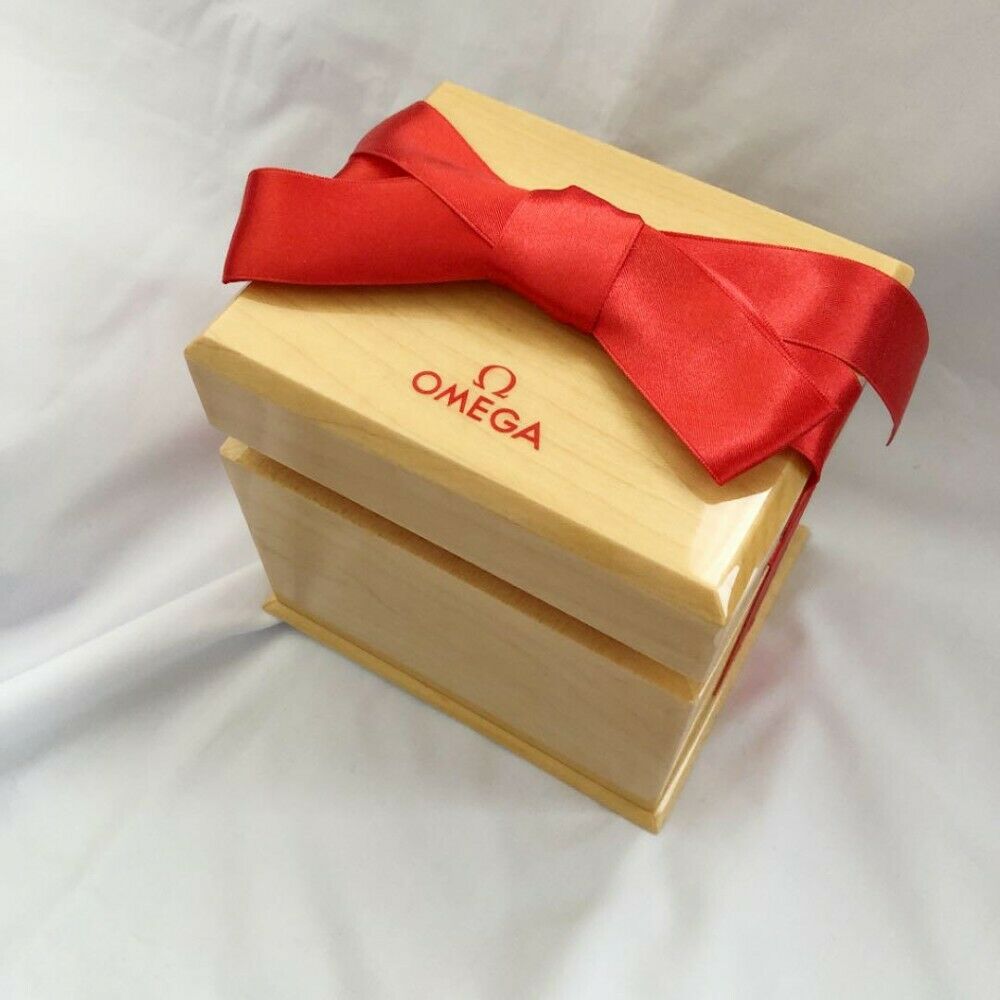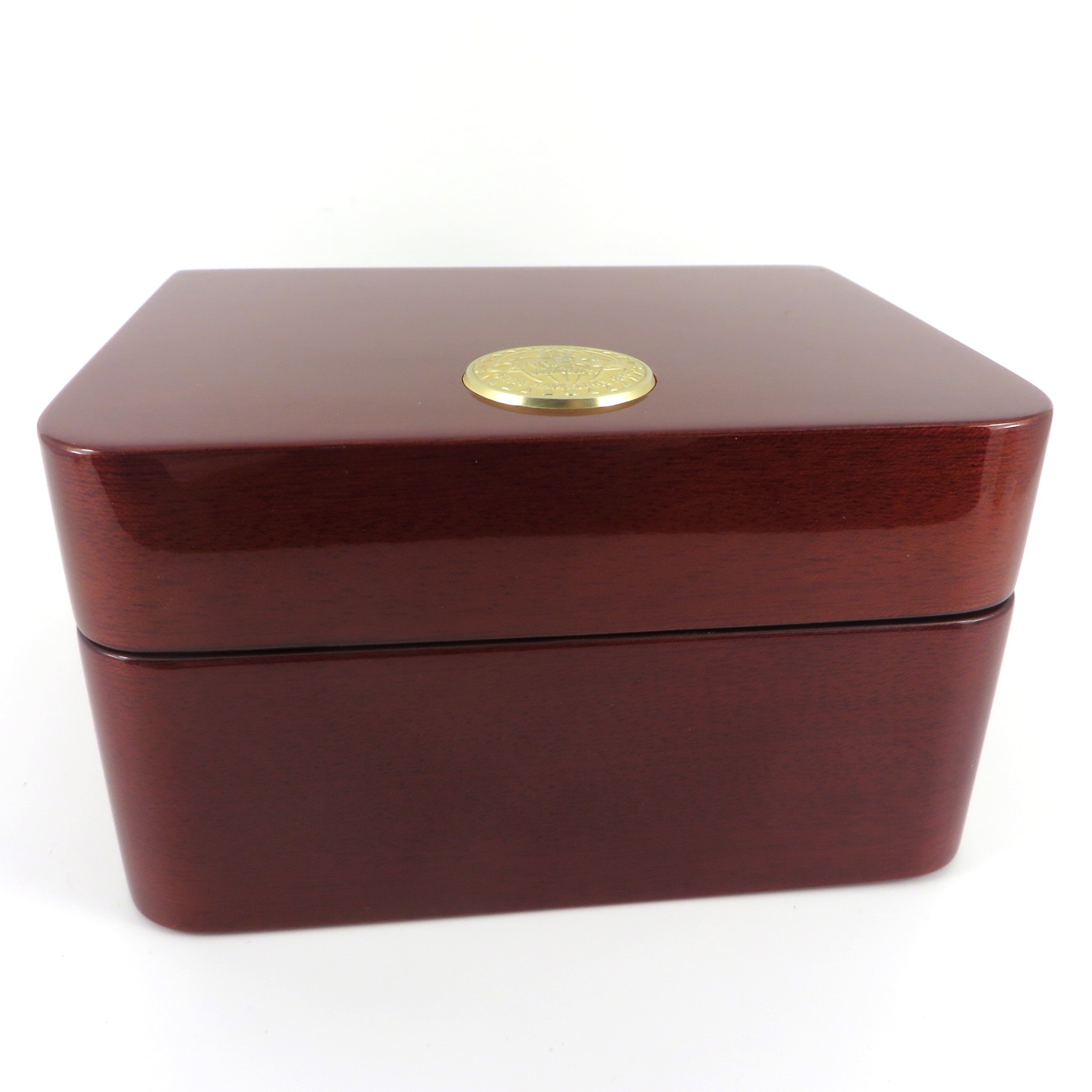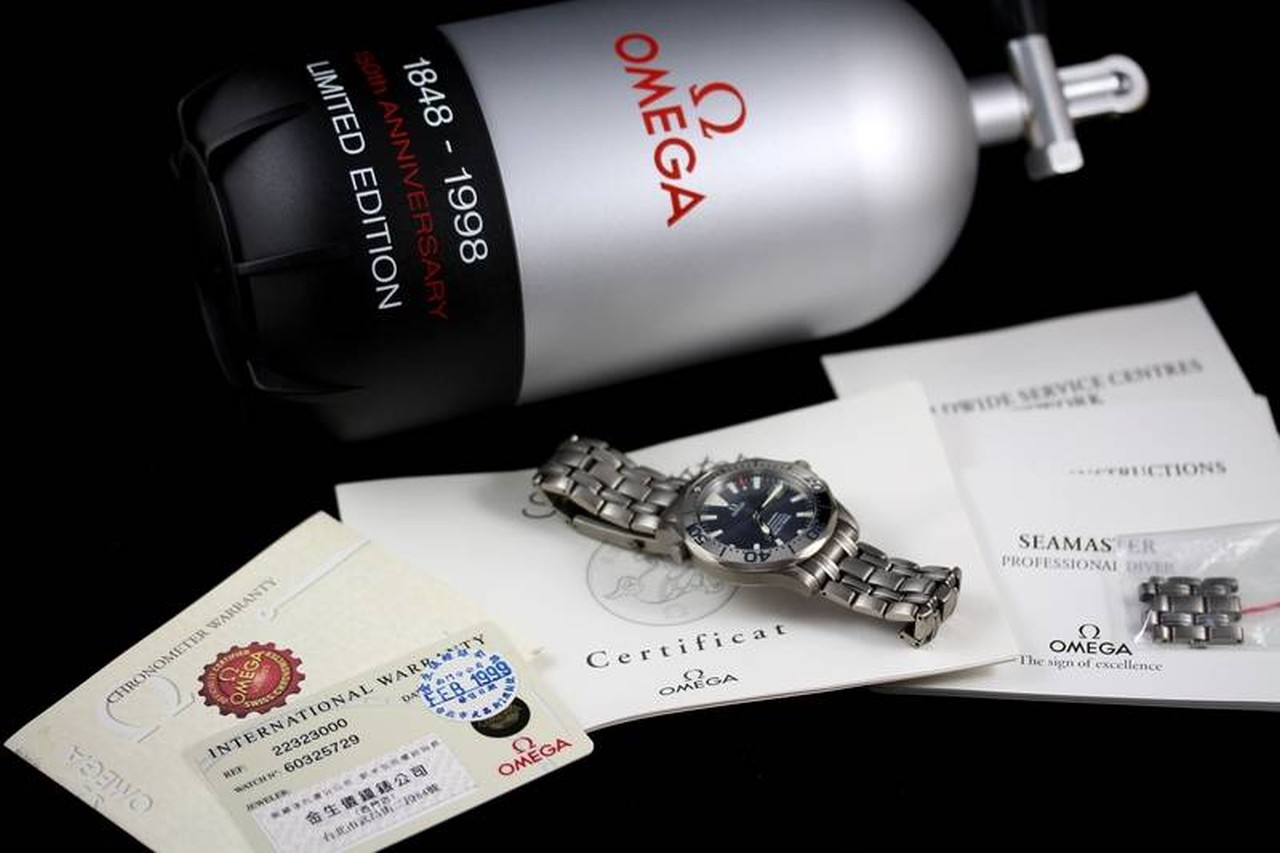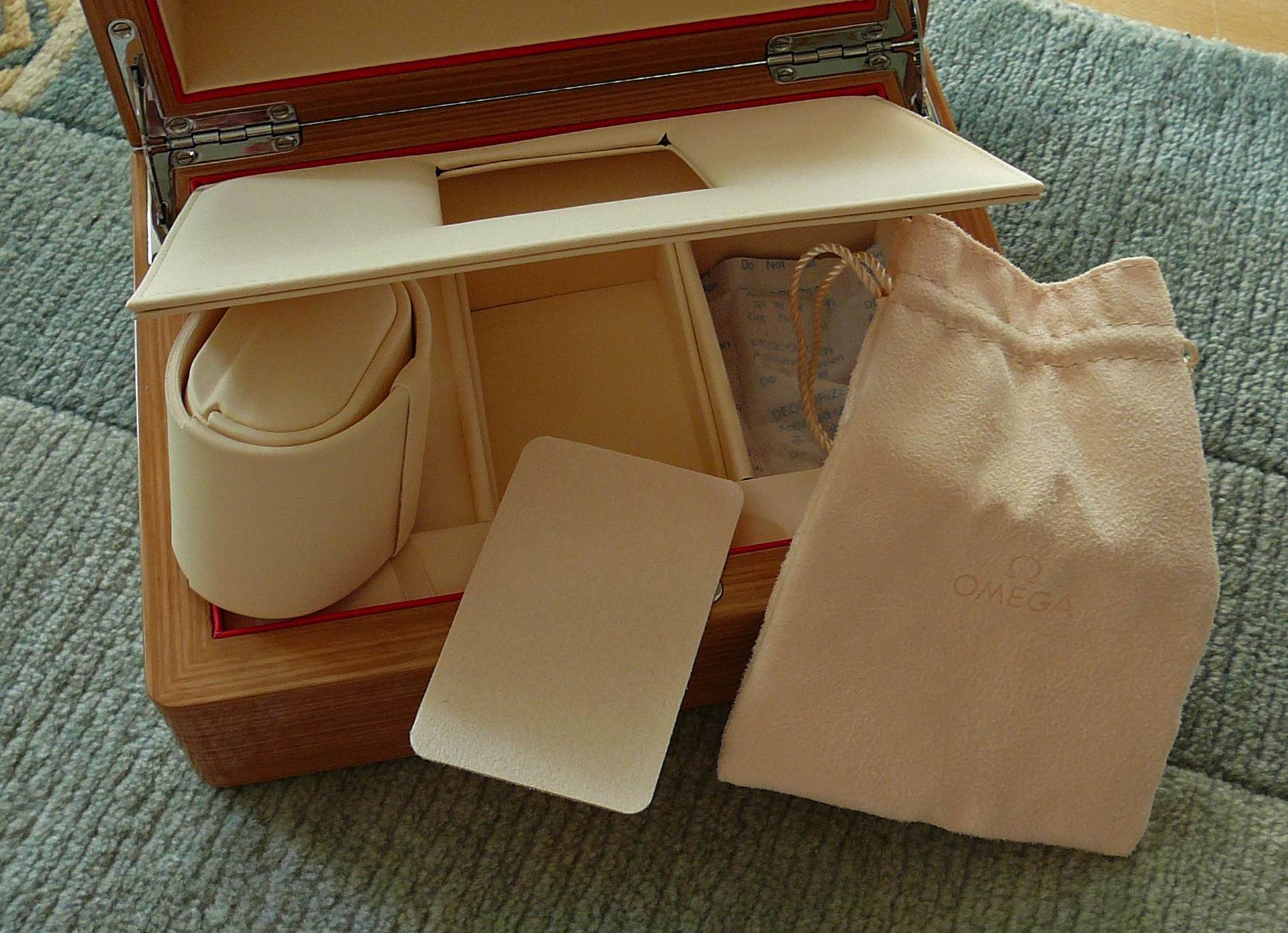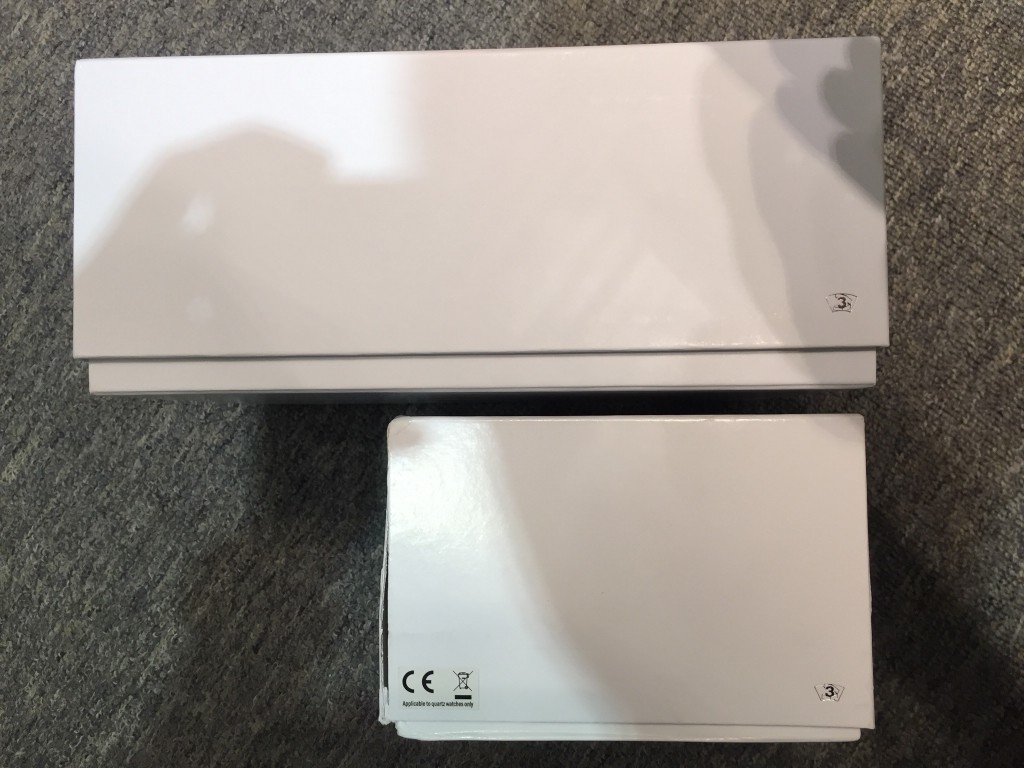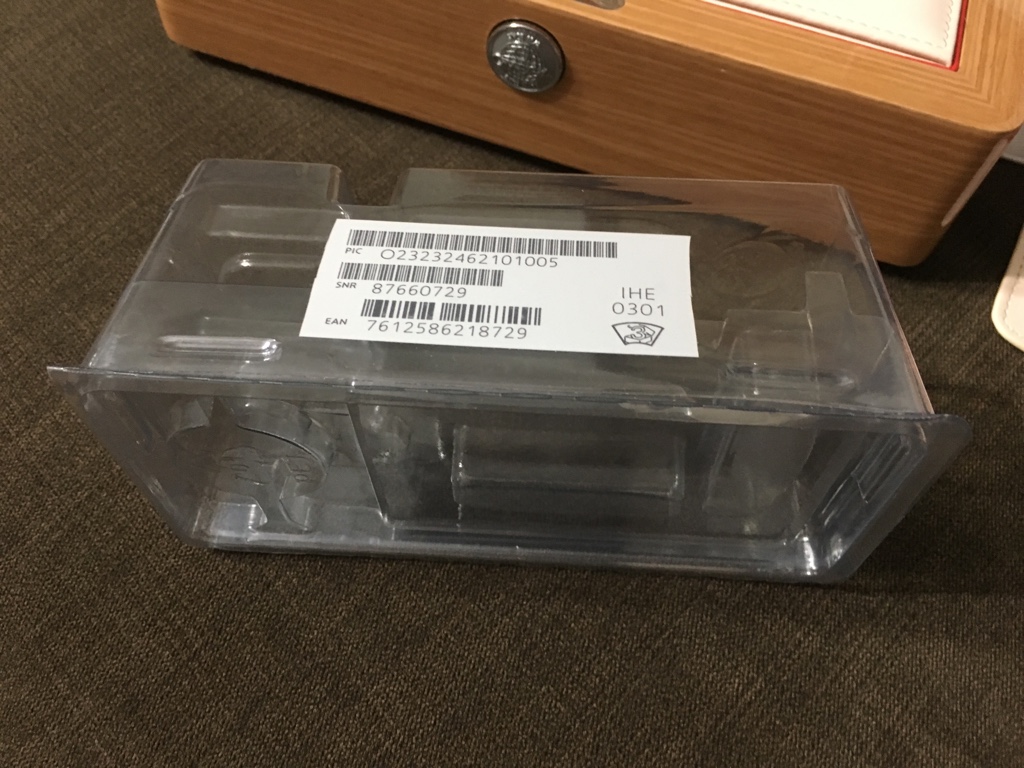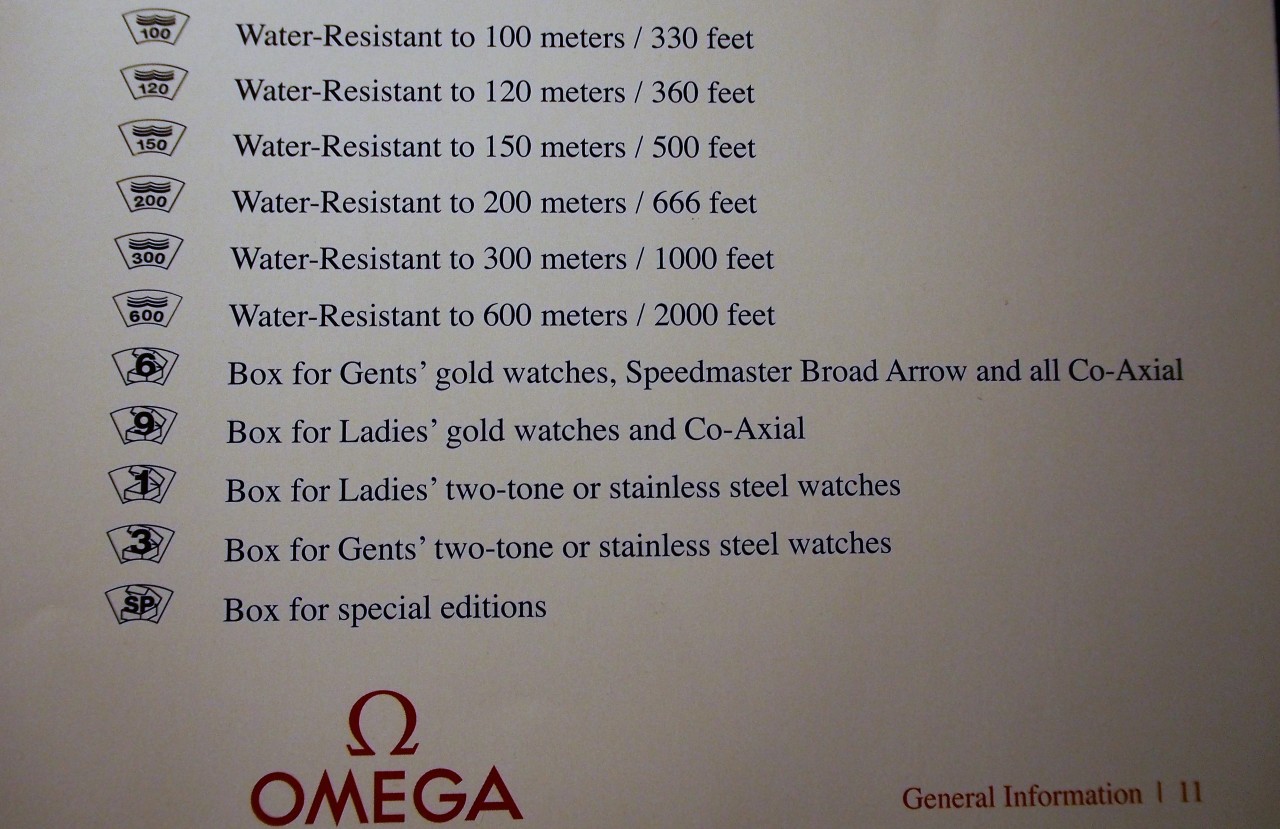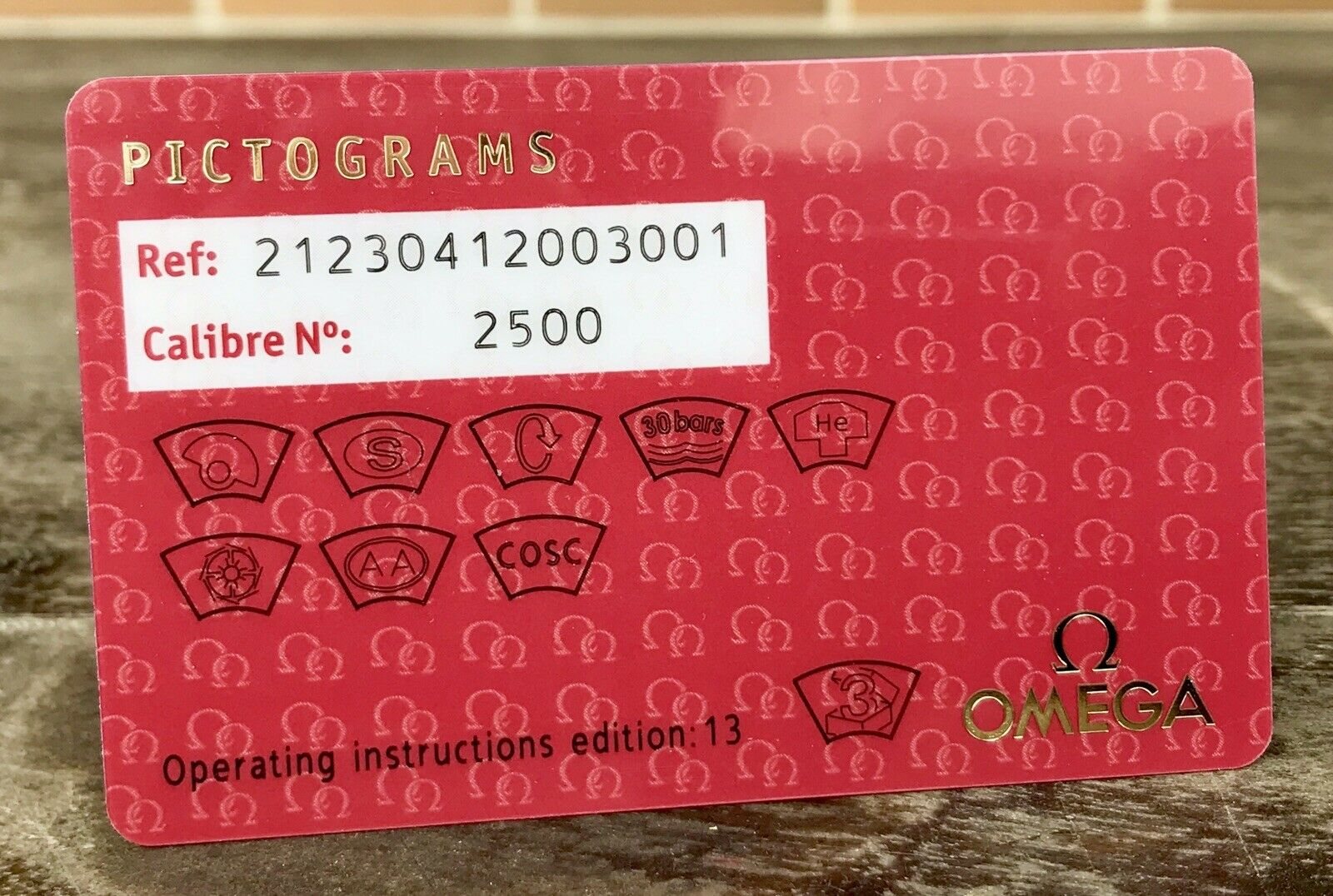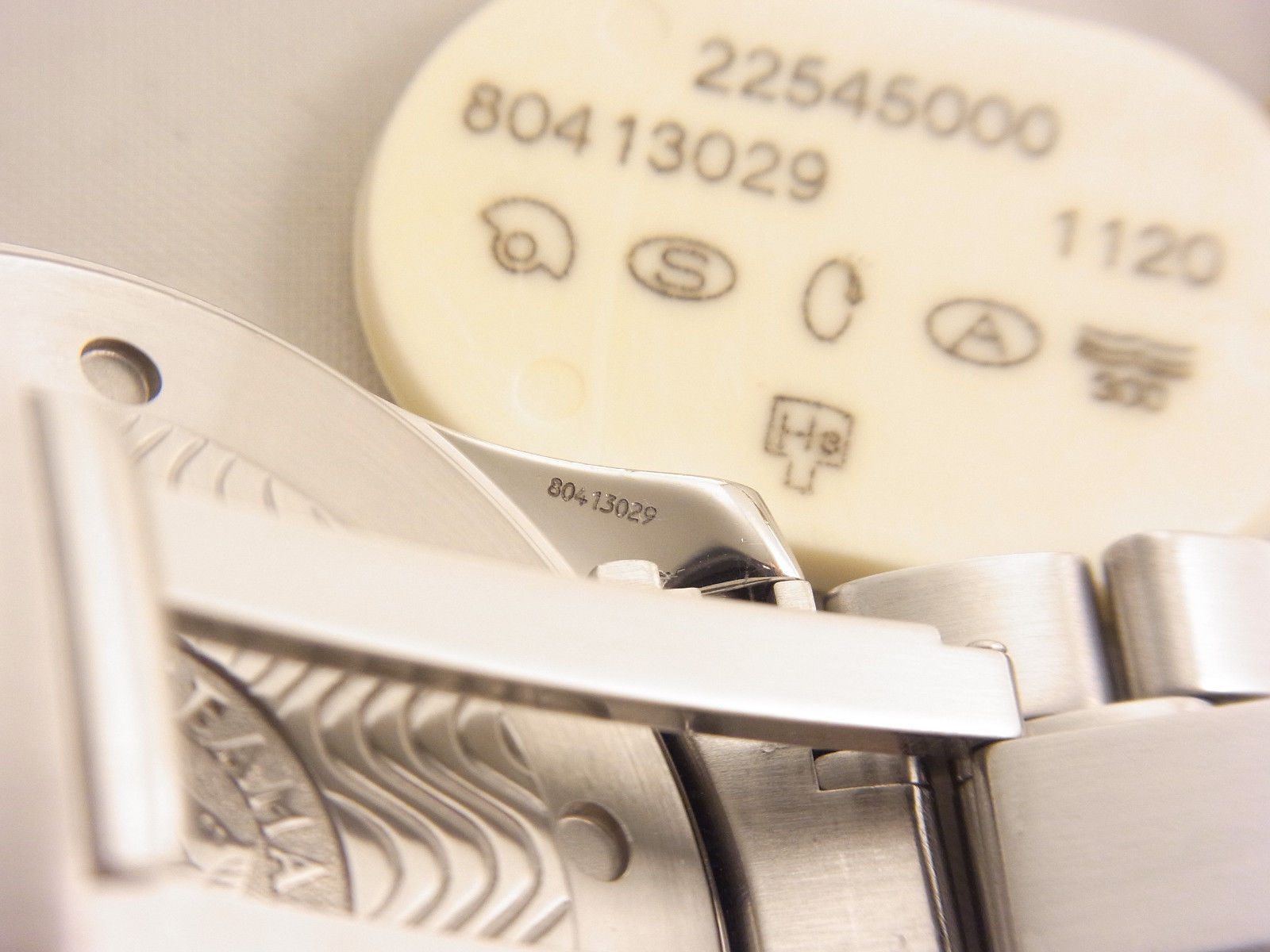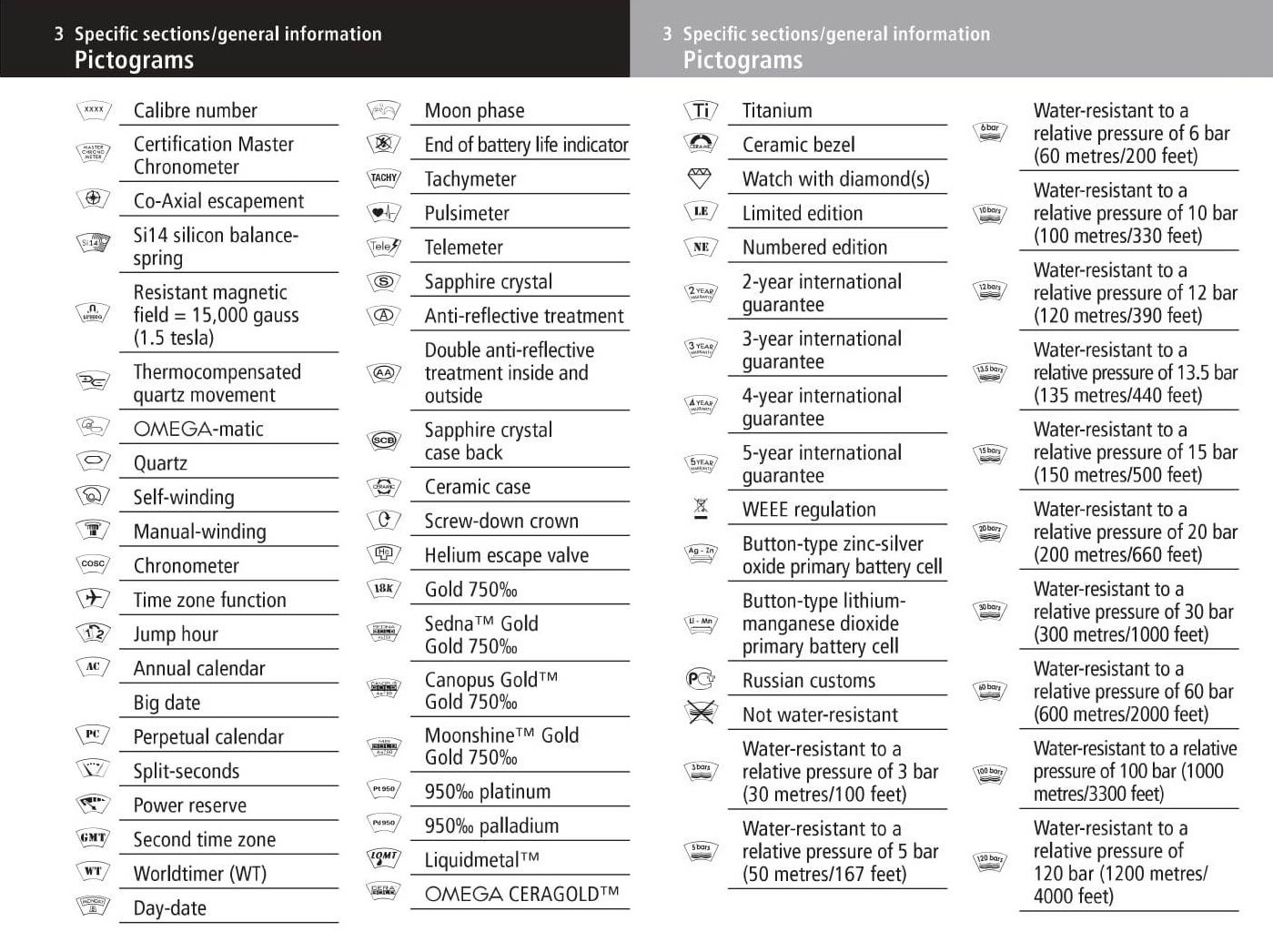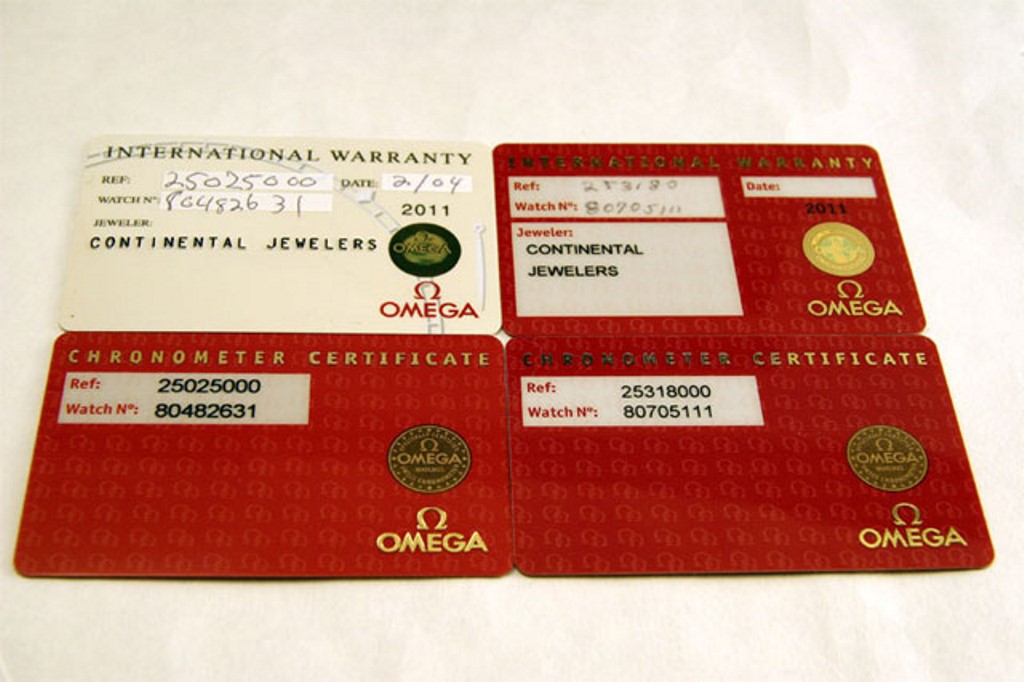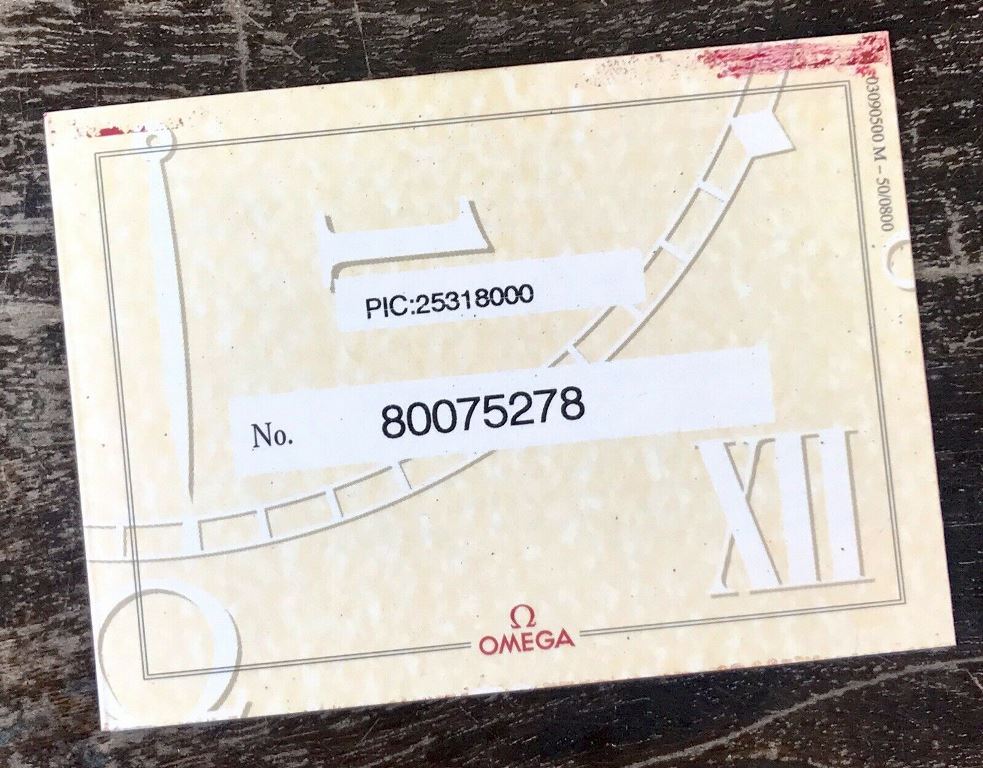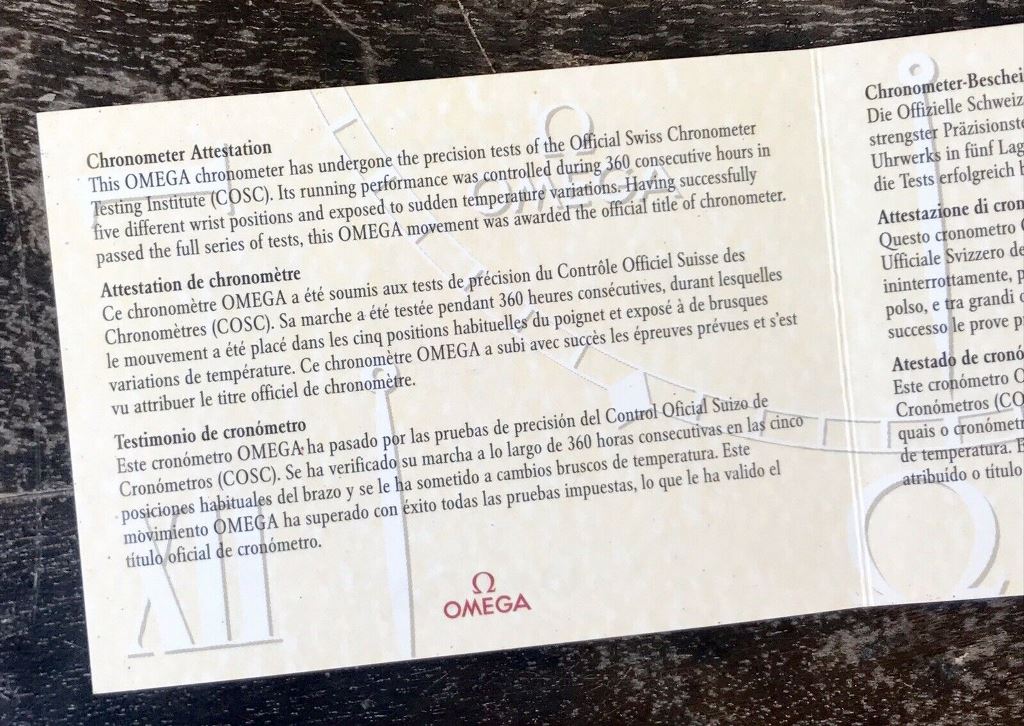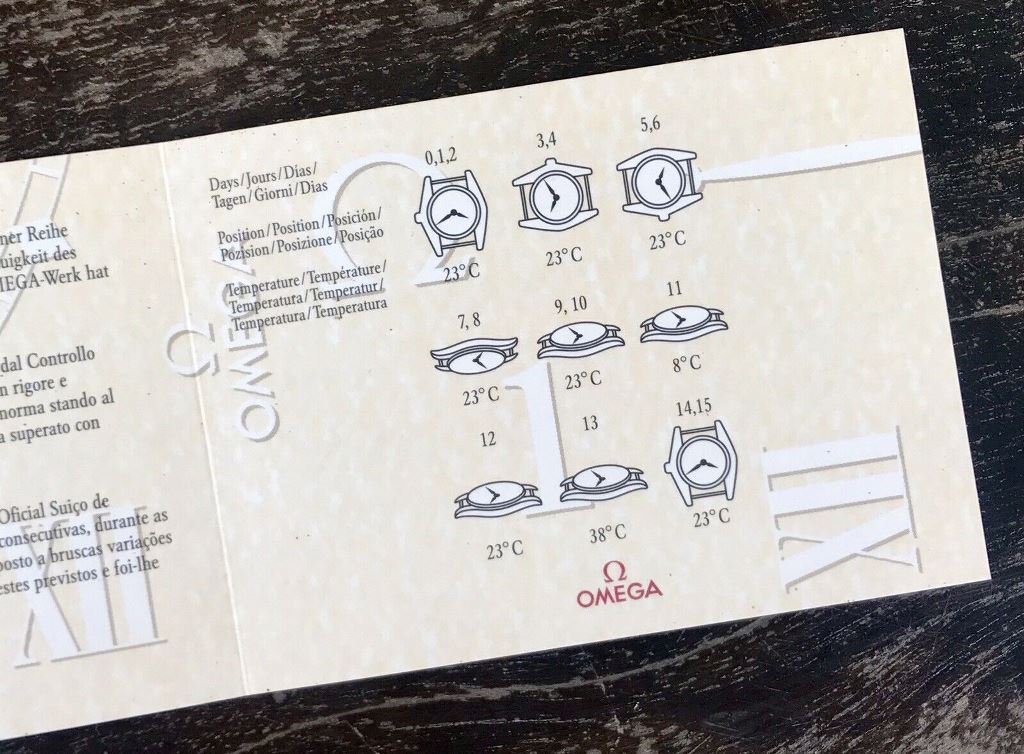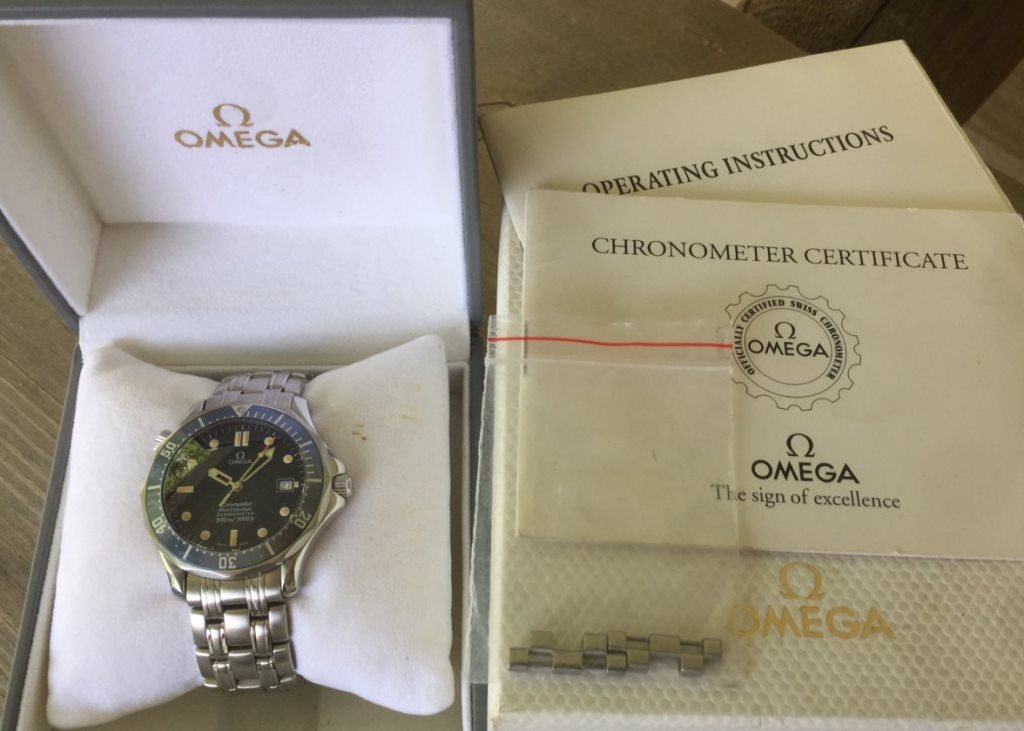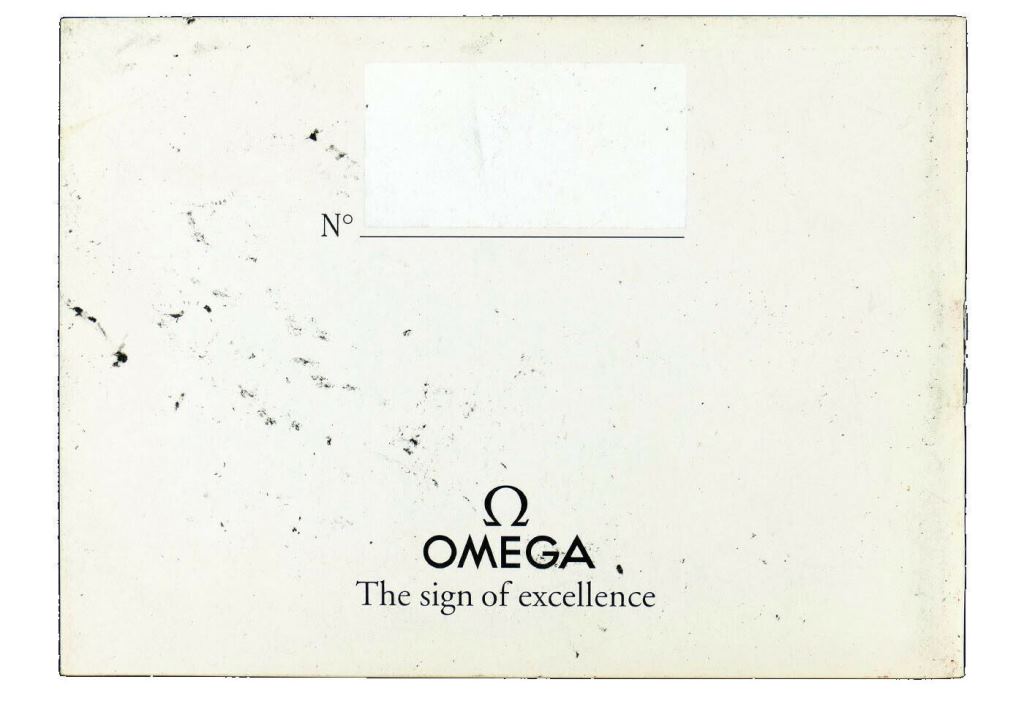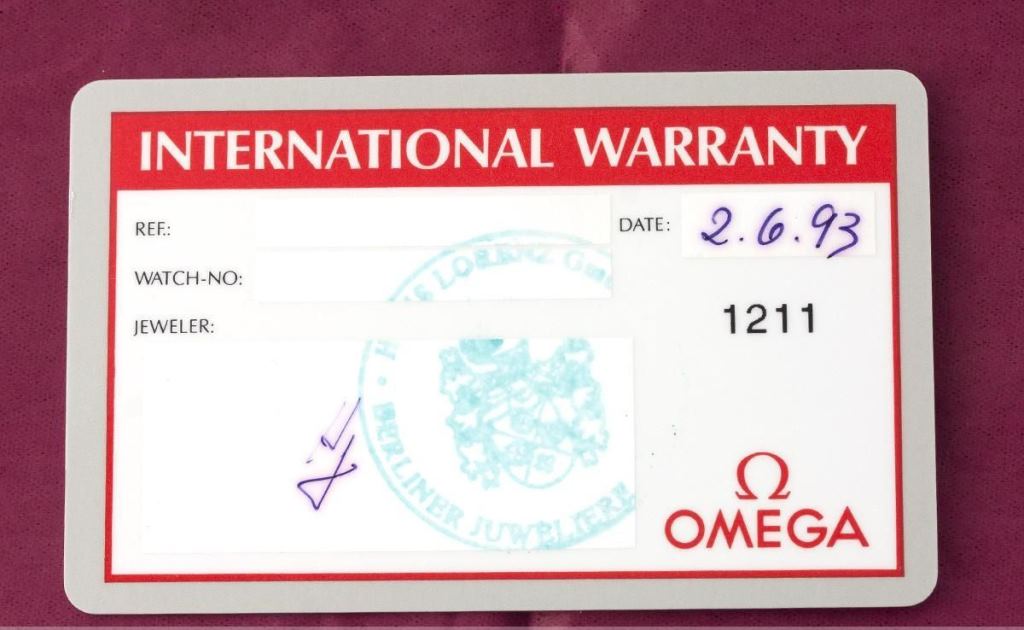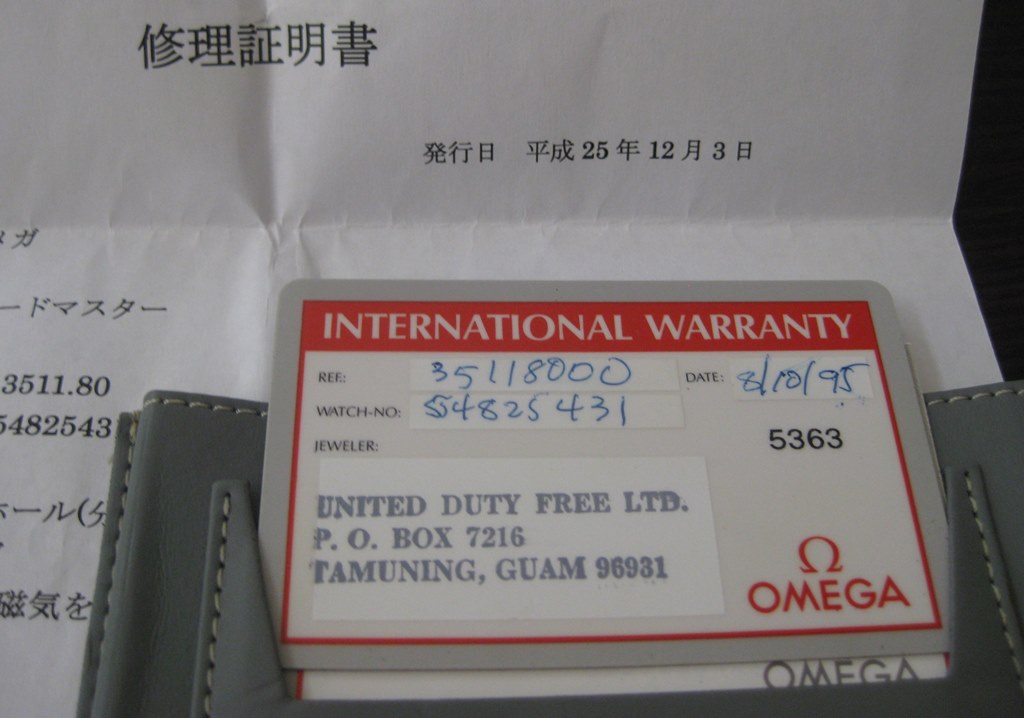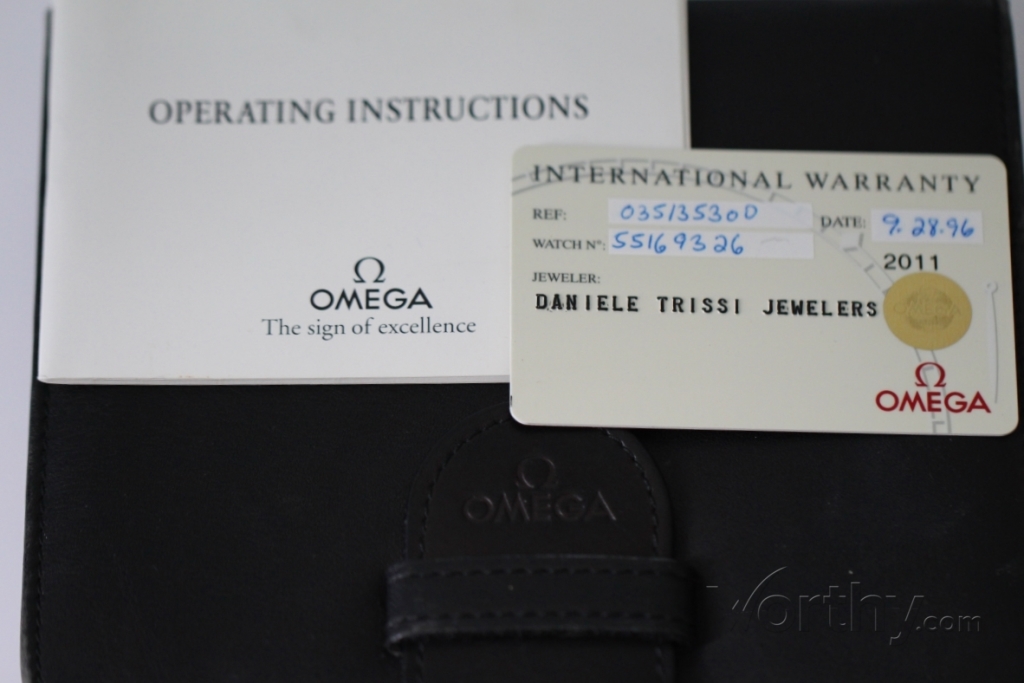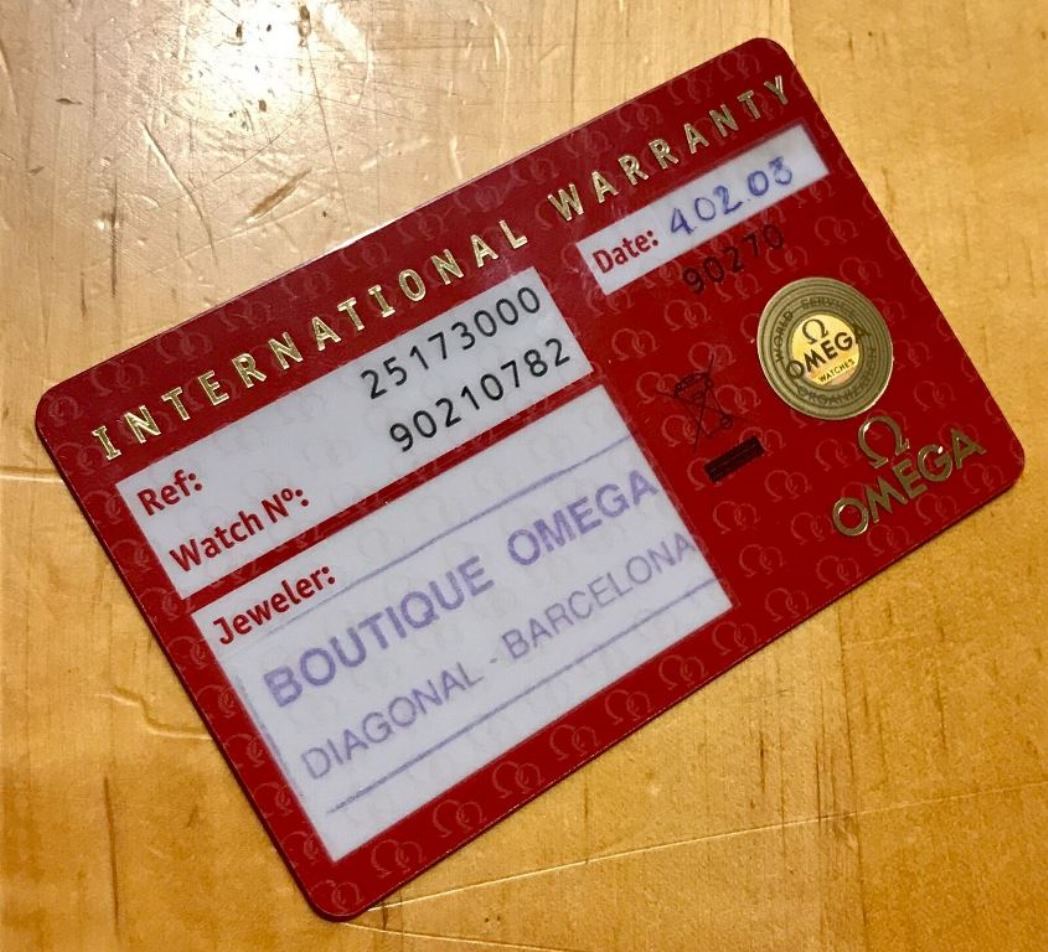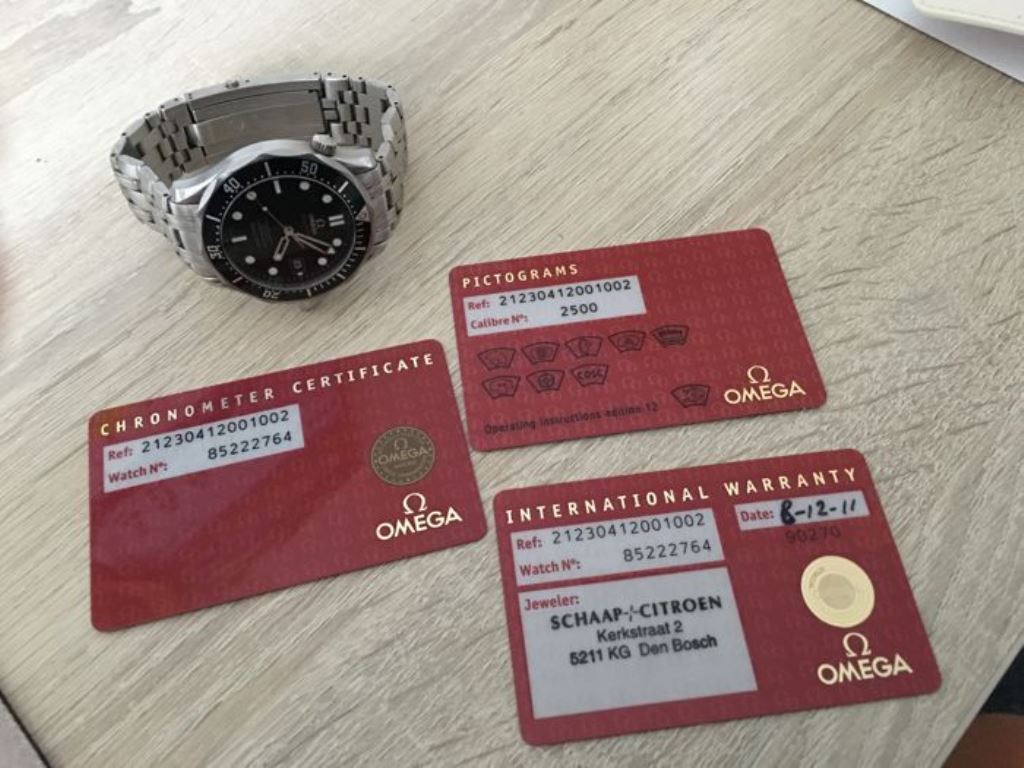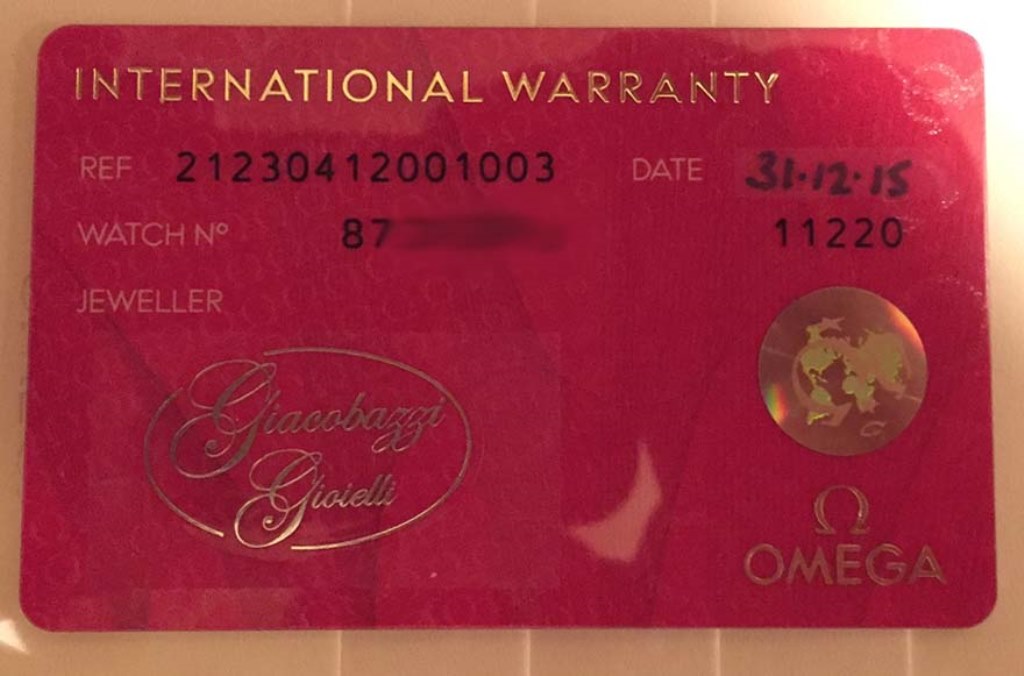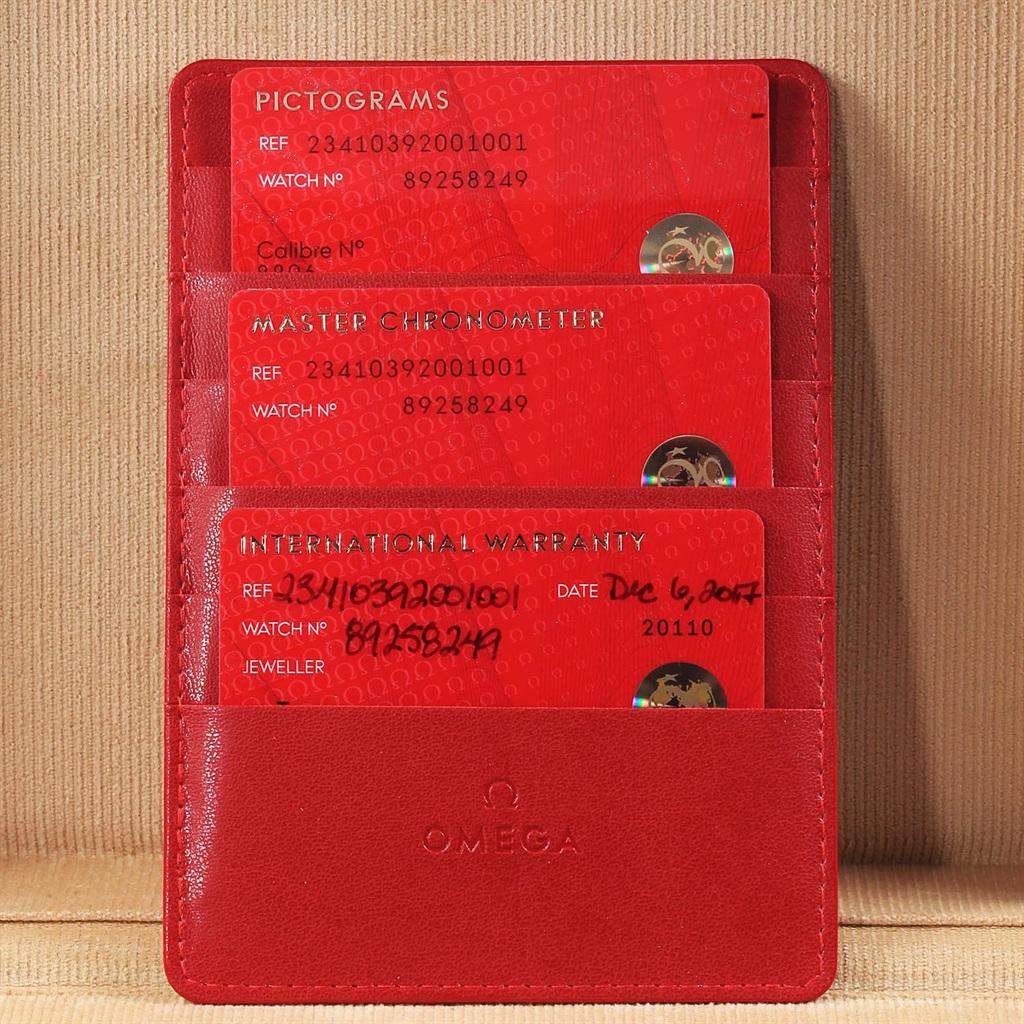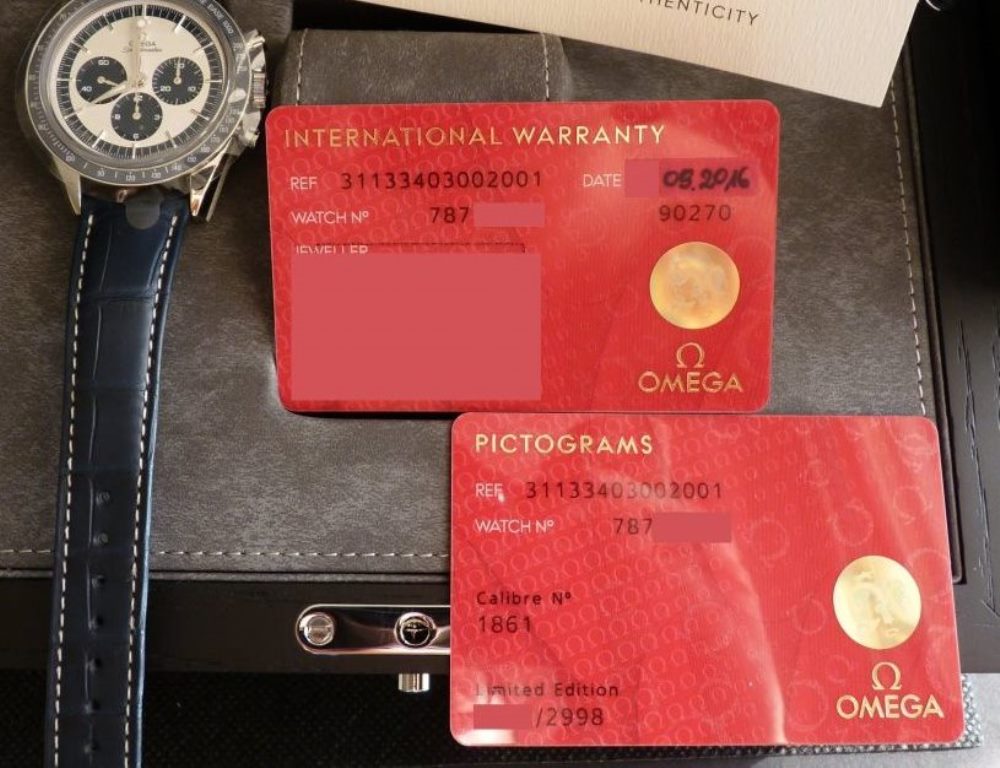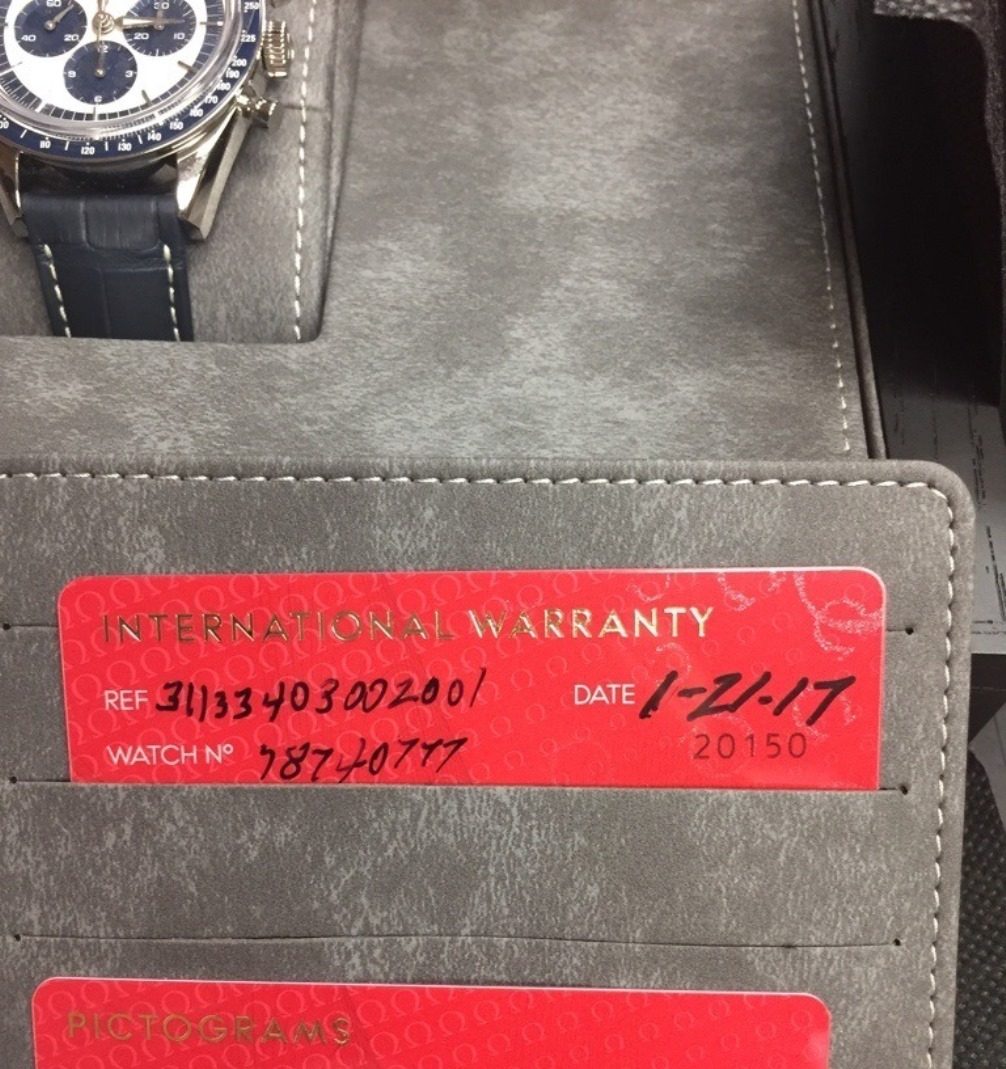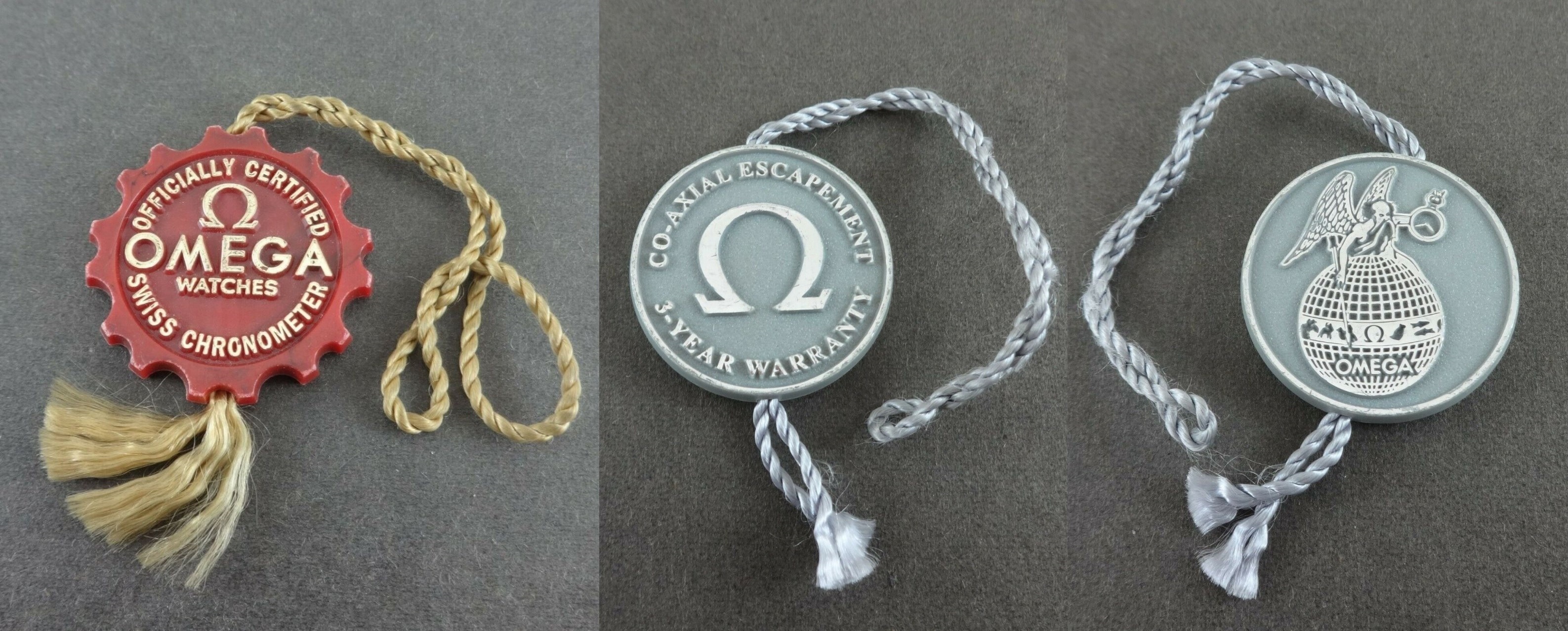- 25/4/15
- 2,944
- 1,236
- 113
In past, R2D4 already started this excercise and has decoded 2531. That thread migh have a photobucket impact now, hereby to be continued.
We do not have any good out of the box reps of pre-ceramic models, and gens are not gonna be any cheaper, hope you find this thread usefull for building your SMP's.
I have focused on those seven models, all chronographs and GMTs are out as I am unsure whether we can use any modern rep case.
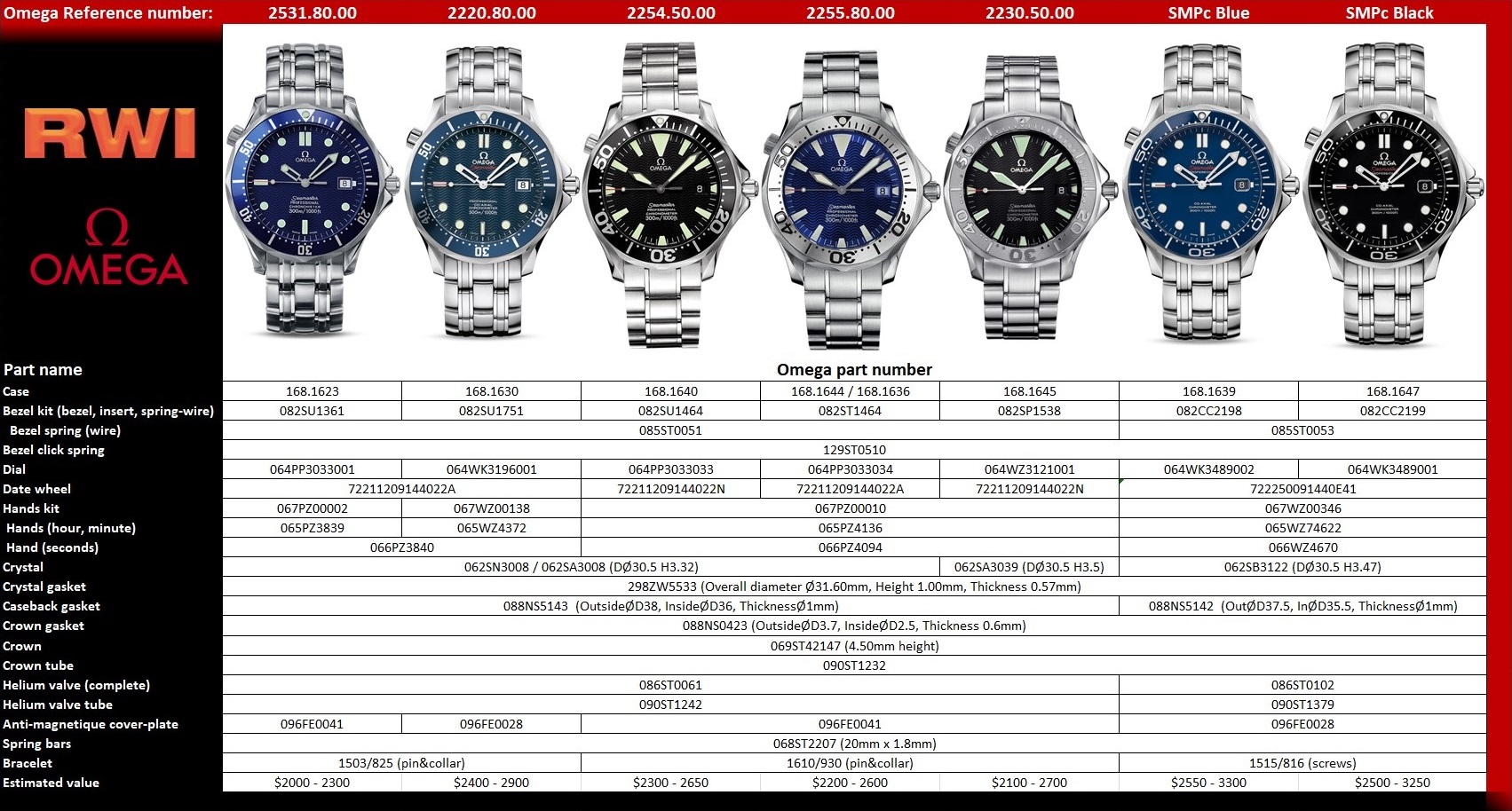
For all those pre-ceramic builds you can use MKS/MKF case. Yes... the maker is advertising them as SMPc reps, but in fact those MK crownguards and lugs are correct for pre-ceramic. MK mid-case has the same height as gen, and it takes the gen crystal, crown/tube and helium/tube without any epoxy.
Kind of the tricky part is with a bezel assembly. If you install a gen spring-wire - most likely gen bezel will get jammed or it will be very hard to turn it. This is because gen spring is too tight for MK case. Either you can mod the gen spring (re-bend it) or buy a thinner (jeweller's) wire and make your custom bezel assembly.
If you ever disassembly a gen SMPc bezel, you will learn there is a new part. It is an extra gasket, probably Omega decided to use it to minimise any shock damage on ceramic insert. This new gasket is 298ZW6007 (fi37.35 / 0.36 / 0.8mm).
Do not buy gen or rep bracelets for chronographs. Chronographs' bracelets do look almost the same as non-chronograph bracelet, but they are not the same. SELs are different and chronograph's SEL will give you a bad fit.
How to read Omega crystals:
SN - no AR coating
SA - AR multilayer coating on one side (inner coating)
SB - AR multilayer coating on both sides
At some point in the time, Omega did a transition and all SN crystals have been discontinued and replaced by SA.
Cannon pinions are skipped, as I couldn't find any logic here. I've seen 2351's with H0 and H2... and seen 2254's with H1 and H3..
So calibre 1120 itself had at least 4 variations here.
2500 calibre looks the same - many cannon pinions are available. As per my eye I THINK that all watches with applied indexes have used H3, or taller.
If anyone can chime in something more valuable here, please do so.
The hand height code
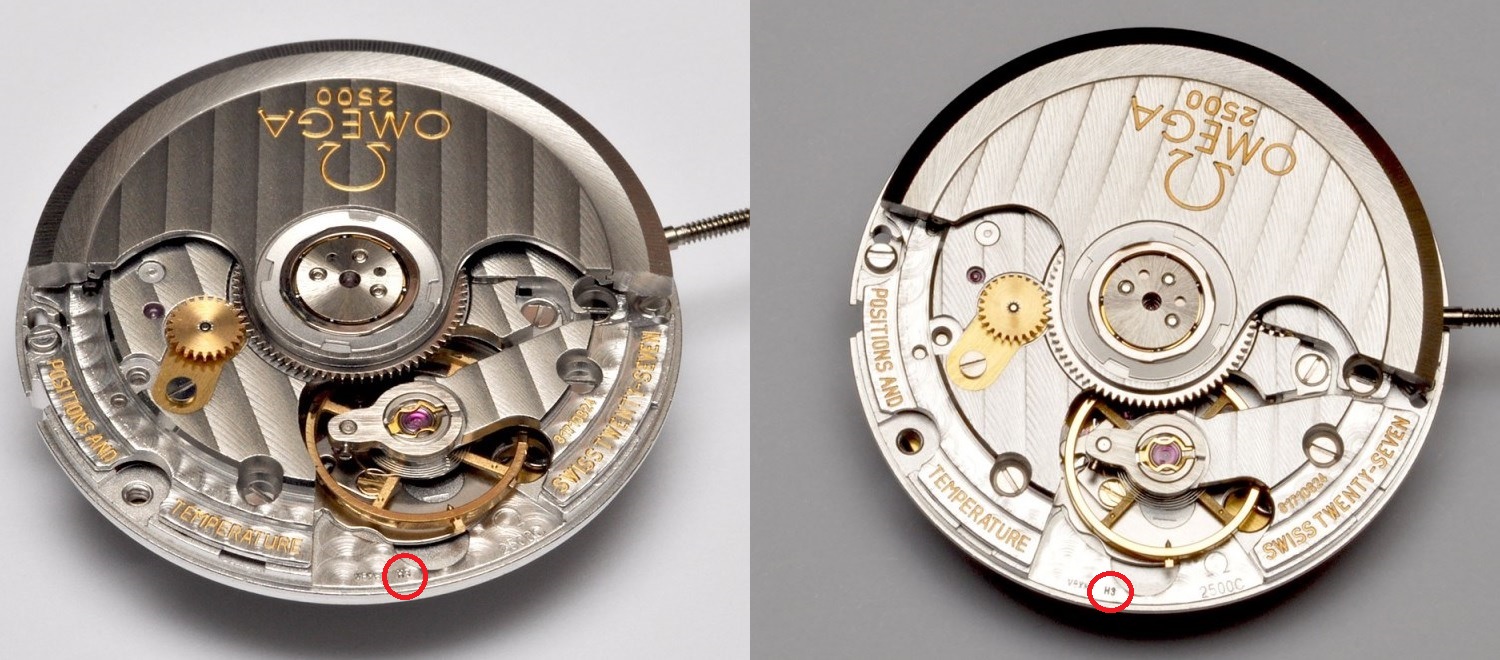
Casebacks.
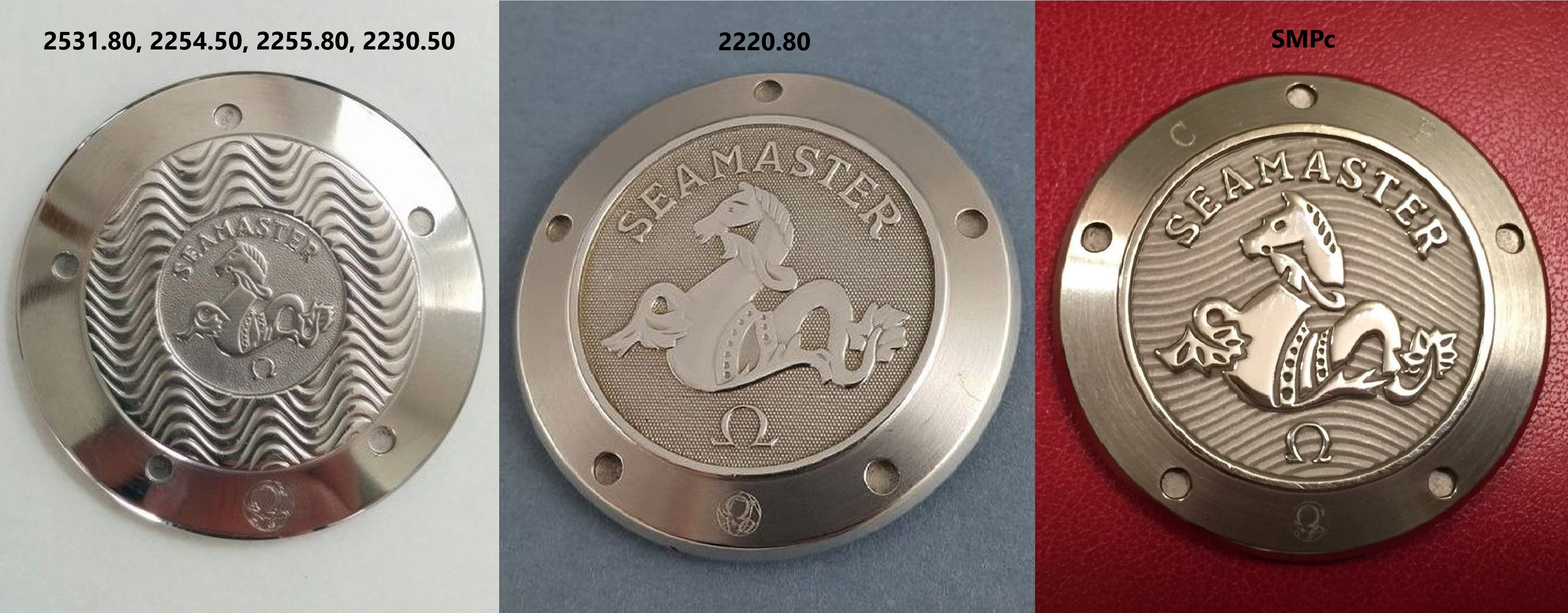
I did not enlist any caseback part numbers, mostly because usually they are not visible, and while you will finally find one on the market - they are bloody expensive.
However, there are 3 layouts of the caseback, but in fact you can find 5 variations of the caseback.
This is because so called "Omega Globe".
Omega tells us they introduced that globe as a new anti-counterfeit security, but true is they used it to combat greymarket, mainly - to sue Costco.
Omega never announced when they started engraving this globe, but Costco lawsuit was in 2007, so all post-2007 watches should have this globe.
First watch with the globe which I have seen was 2003, so 2003-2007 is a somewhat of a grey area - those casebacks can have it, but it is not a must (see Period Correct section in below).
Parts for Automatic/quartz/full-size/mid-size.
Thing is the world is full of mid-size quartz for sale and parts for automatic full-size watches are like unicorns.
Especially the dials can be an expensive mistake, so here is a chart how to tell the correct dial without knowing its part number.
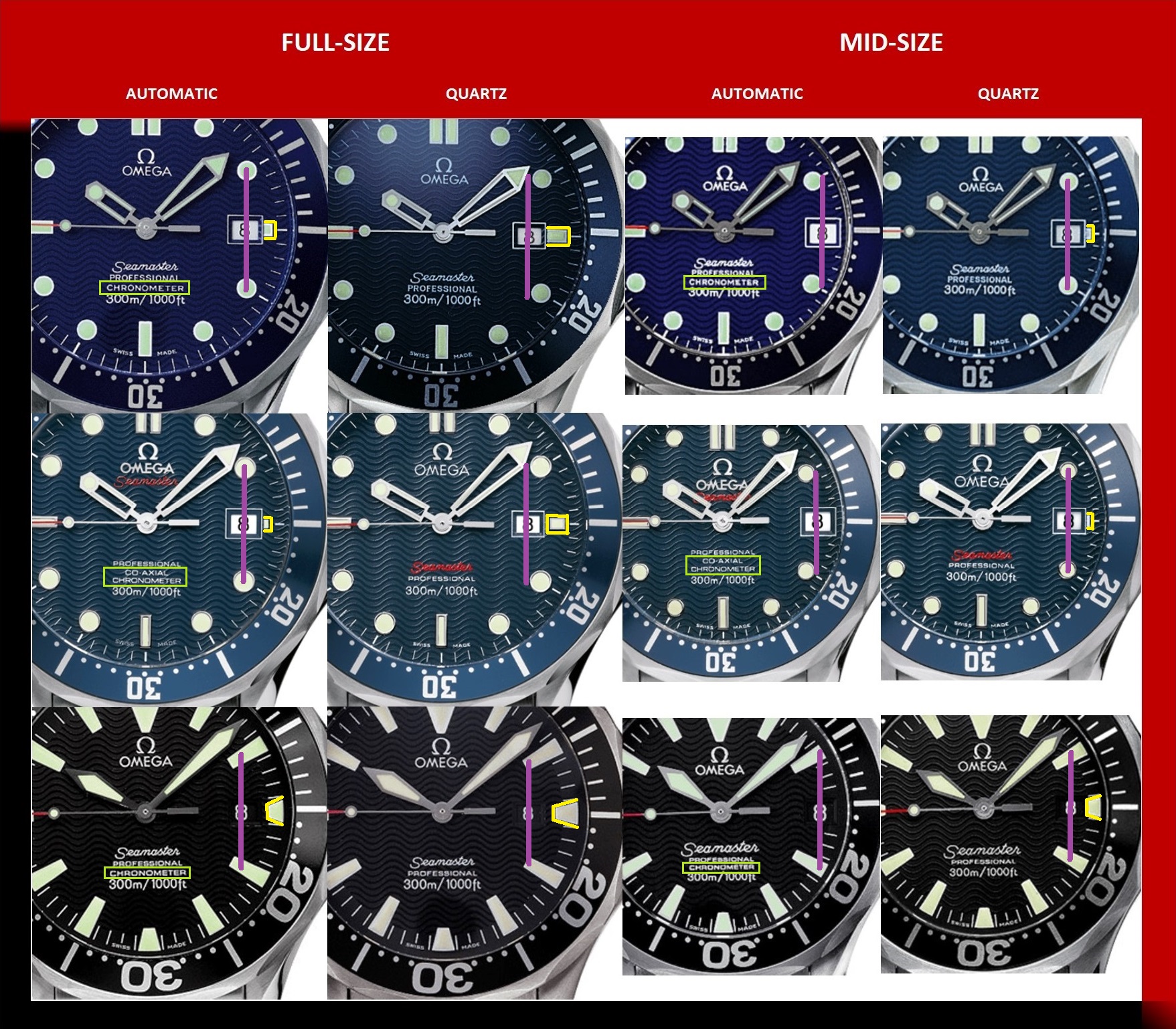
I did a gfx for 3 models only. but you should be able to see the pattern.
Also mind that hands for quartz movement won't fit your Asian ETA as quartz hands and automatic hands are not interchangeable.
Being Period Correct:
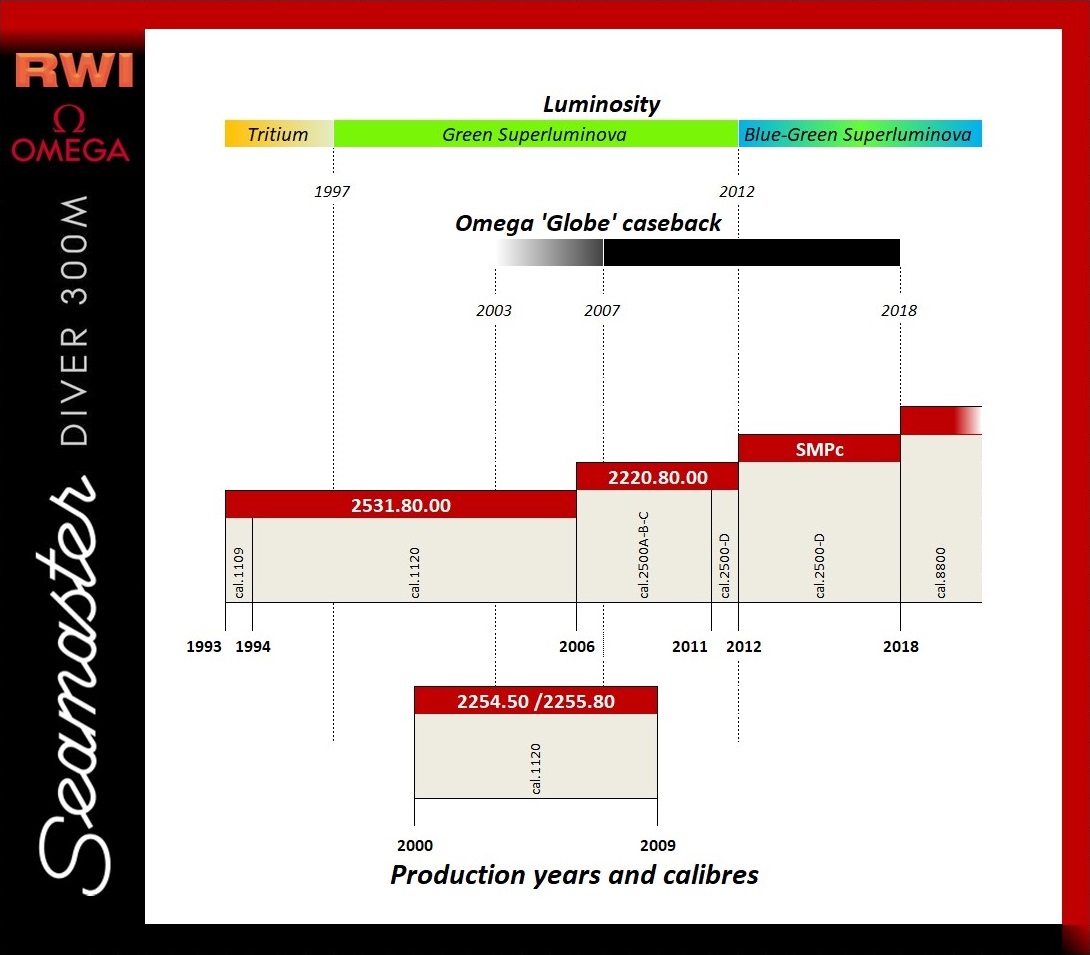
Late 2011 2220.80's were fitted with updated calibre - 2500D so it is possible to build such watch but I do not know a part's reference number for this date wheel.
That btw is very good example of the transitional watch.
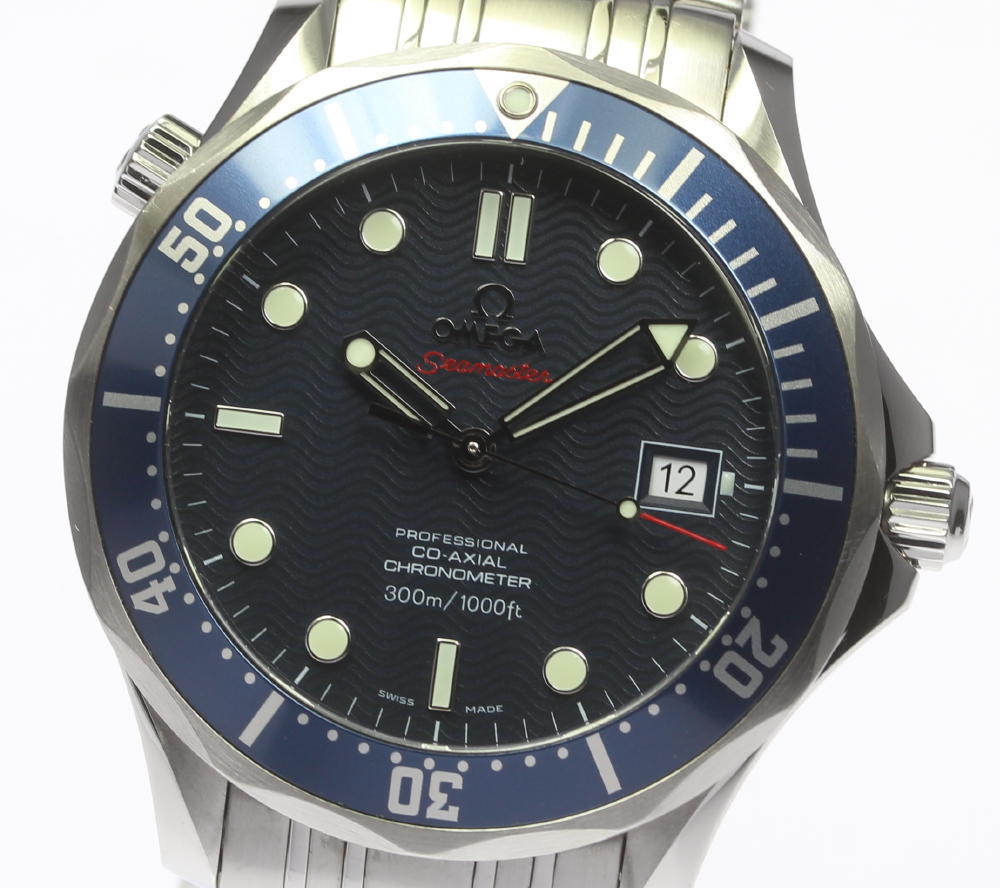
Be carefull when you buy the parts for Big triangle/Sword hands models.
Omega has offered those watches in both - in steel and in titanium. Titanium came out first (circa 1998) so on the market there may be more parts for titanium watches.
Both, steel and titanium watches have Superluminova but it has a different colours. Luminosity on titanium dials/hands is more whiter and lume on parts from steel watches is more greenish. Avoid mixing them or during a daylight you will see a mismatch in the colour of the lume.
Tritium.
Tritium was used on the regular dive watches and chronograph watches, but only models with skelotonized hands have had it.
"Tritium sword hands watch" simply does not exist.
As you can see here we have only one SMP with tritium. It was 2531.50.00 produced between 1993 - late 1996/1997.
While there were never any 'T's used on this dial - here is how to tell the difference between tritium and superluminova.
Pretty fresh service dials - the difference in matte vs glossy lume application is a pretty obvious tell.
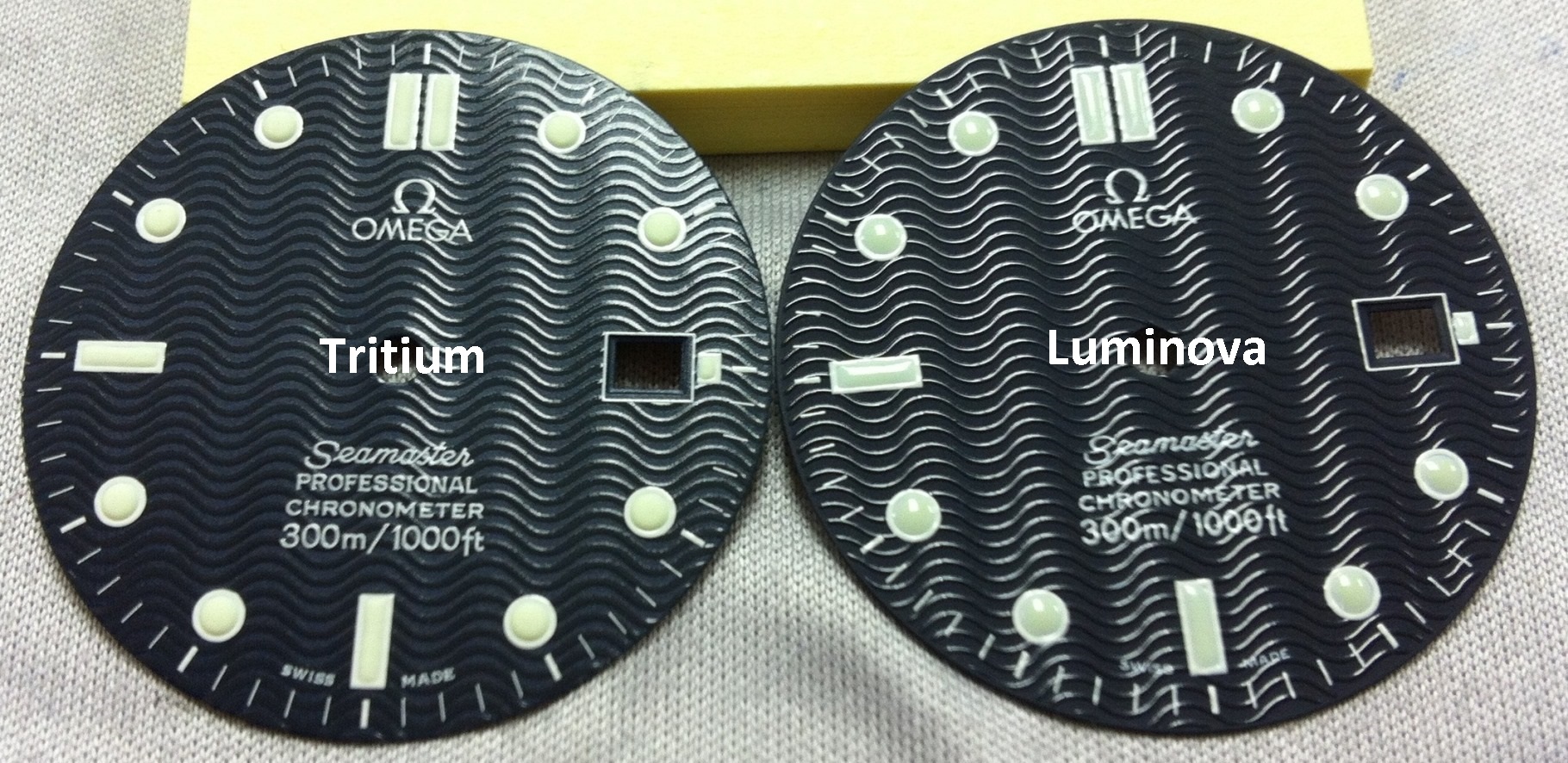
Also, the writting has changed slightly.
- 3 in "300" and 1 in "1000" do have small serifs on tritium dial,
- "ft" symbol is flat on a tritium dial and it is tall on superluminova dial.
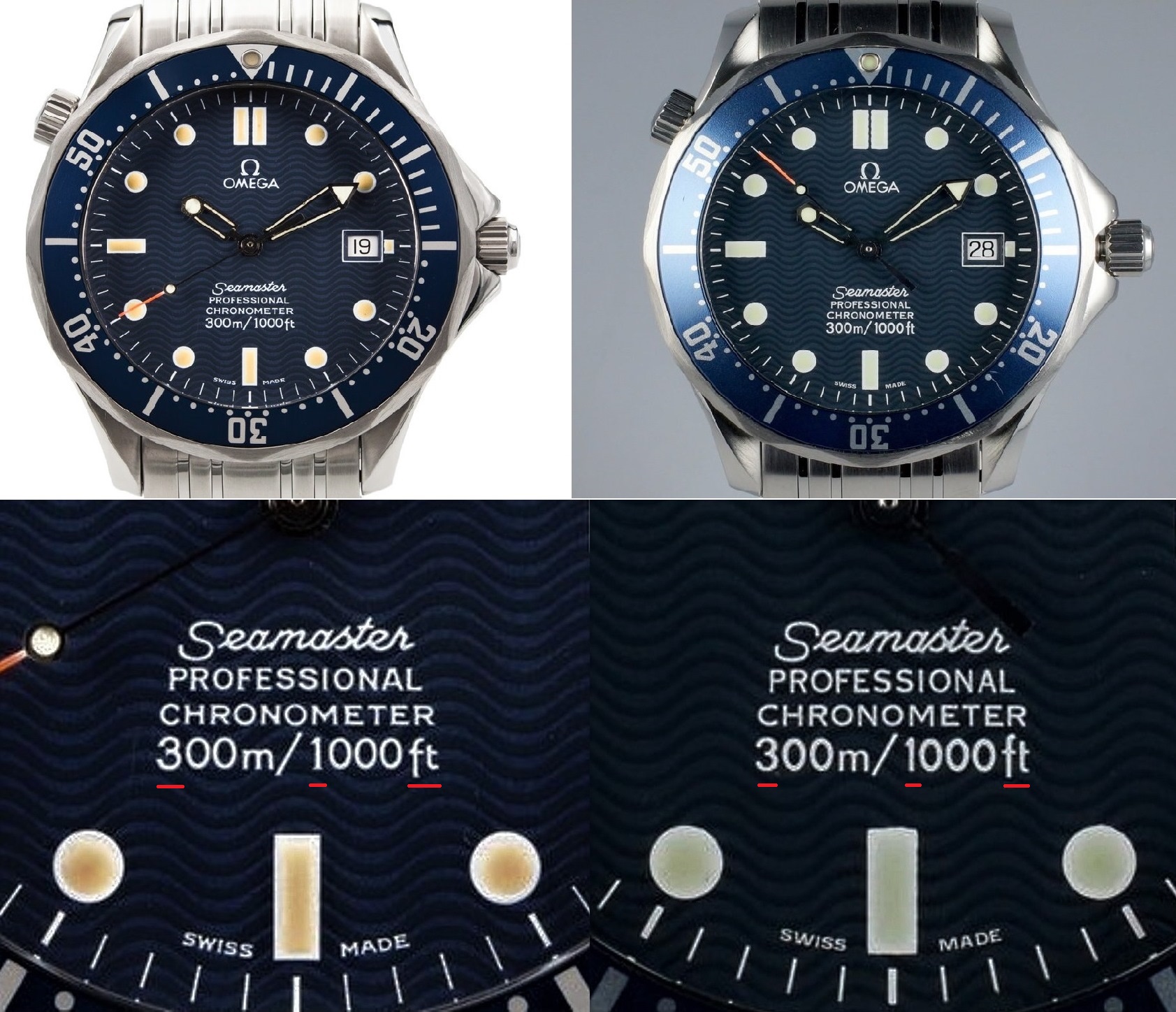
If you ask me.. tritium 2531 is a sweet project worth bothering. It is the sleeper, a future collectibles.
Early production SMP.
If you are very much into this model, you know that the first batch of this watch was somehow different than all later 2531's.
I am referring to 1993 - mid.1994 watches powered by 1109 calibres.
Those models had more aesthetical differences, like:
> dial without the "Chronometer" writting (but it is neither the Quartz dial layout),
> case number 168.1503/196.1503,
> helium valve with a bold cap (no logo),
> bracelet was still 1503/825, but SEL were not stamped. Also; SEL, clasp-links and clasp have a different shapes than what we know from the later 1503/825 bracelets.
Over the watch fora there is a story that first batch was delivered to the Italian ADs only. Omega never confirmed that. While this is a cool story it is not really true as those watches have been seen sold with the papers issued by the ADs from various countries.
I have skipped this early production model as parts are not dime a dozen and quite frankly this watch itself in general is considered as fugly and not really collectible, yet.
It may have change down the road in next 10-20 years, who knows.
Here are some pics of the early automatic "no-cosc" watch.
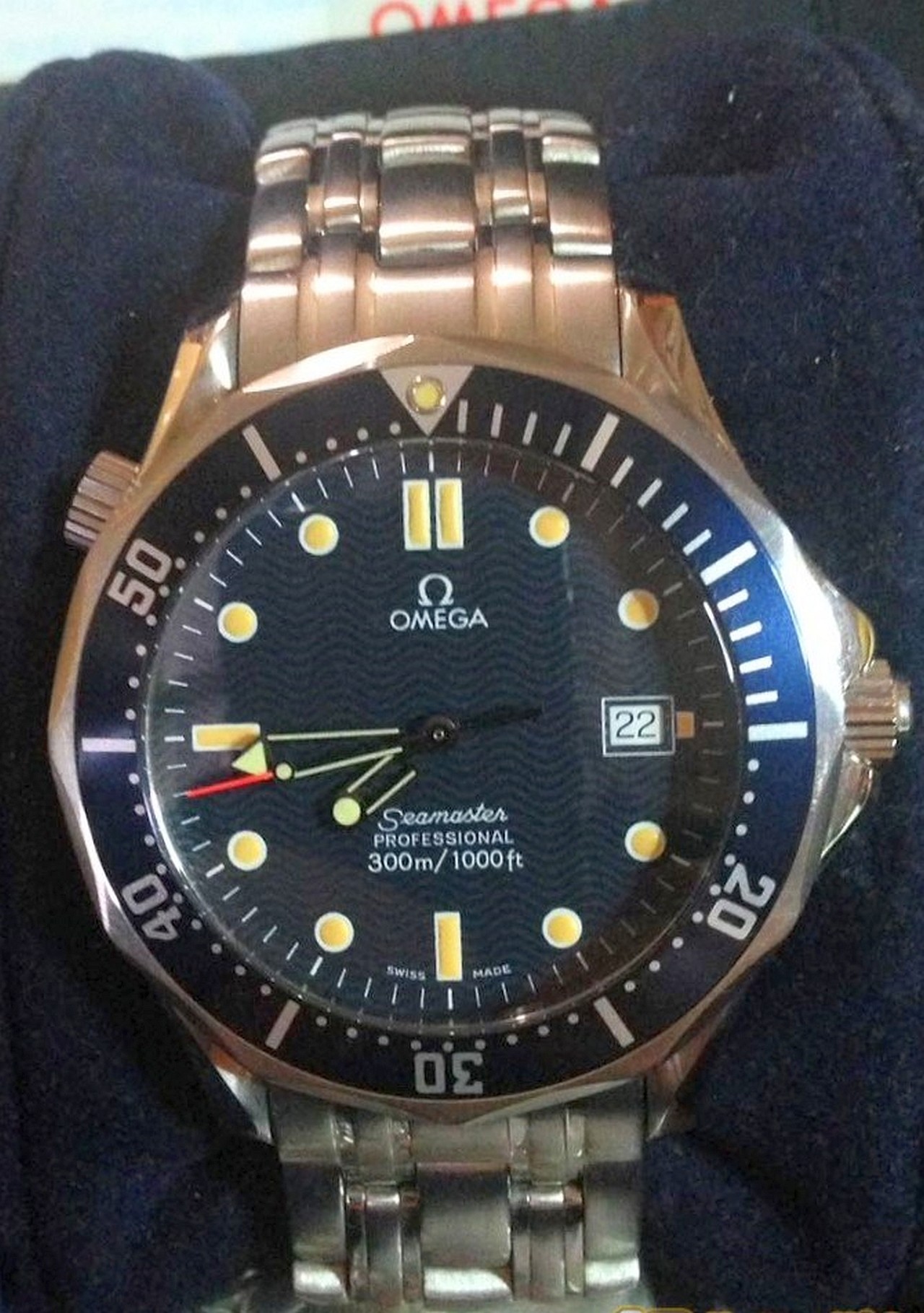
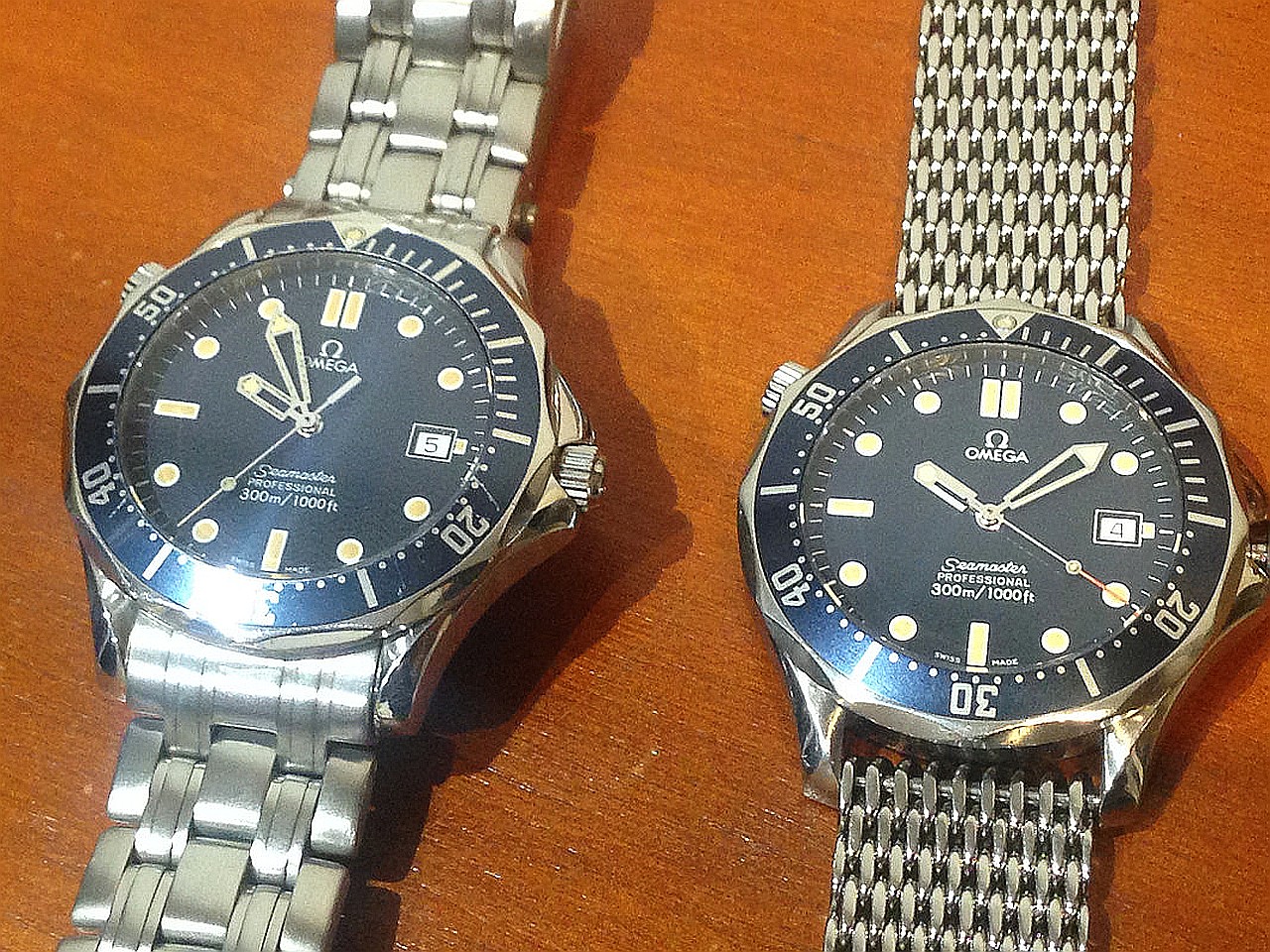
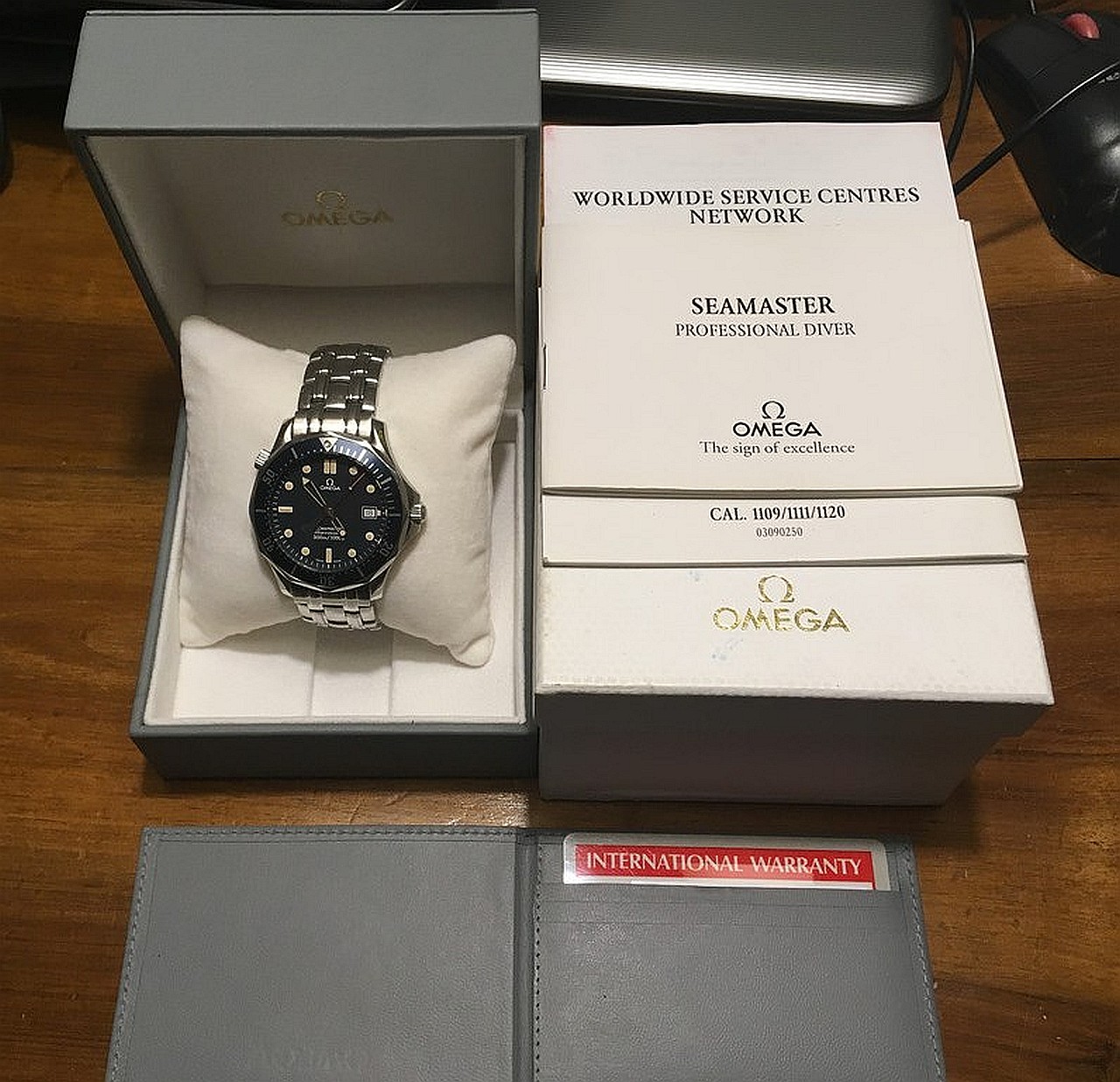
This watch is also reffered as 2531.86.00, though Omega's watchfinder does not have any record for such reference number.
Anyway, try to avoid purchasing 090ST1231 case tube. This is early production part and it is a push-in tube, all other (later) tubes are threaded tubes.
Helium valves.
We do have two valves, of course the caps are the obvious but not the only difference.
Some parts like a screw and gaskets are the same but in general do not assume that all smaller parts are interchangeable.
I think the easiert way is to buy a complete valve, in case you ever need to assembly one from the small parts - here is the spec.
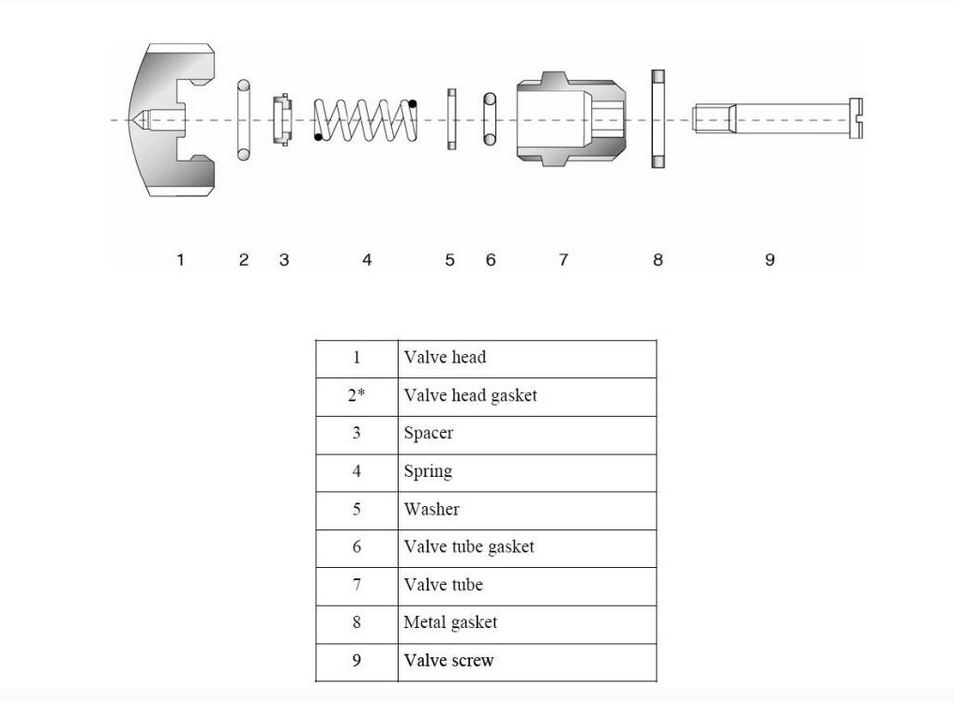
Happy frankening.
We do not have any good out of the box reps of pre-ceramic models, and gens are not gonna be any cheaper, hope you find this thread usefull for building your SMP's.
I have focused on those seven models, all chronographs and GMTs are out as I am unsure whether we can use any modern rep case.

For all those pre-ceramic builds you can use MKS/MKF case. Yes... the maker is advertising them as SMPc reps, but in fact those MK crownguards and lugs are correct for pre-ceramic. MK mid-case has the same height as gen, and it takes the gen crystal, crown/tube and helium/tube without any epoxy.
Kind of the tricky part is with a bezel assembly. If you install a gen spring-wire - most likely gen bezel will get jammed or it will be very hard to turn it. This is because gen spring is too tight for MK case. Either you can mod the gen spring (re-bend it) or buy a thinner (jeweller's) wire and make your custom bezel assembly.
If you ever disassembly a gen SMPc bezel, you will learn there is a new part. It is an extra gasket, probably Omega decided to use it to minimise any shock damage on ceramic insert. This new gasket is 298ZW6007 (fi37.35 / 0.36 / 0.8mm).
Do not buy gen or rep bracelets for chronographs. Chronographs' bracelets do look almost the same as non-chronograph bracelet, but they are not the same. SELs are different and chronograph's SEL will give you a bad fit.
How to read Omega crystals:
SN - no AR coating
SA - AR multilayer coating on one side (inner coating)
SB - AR multilayer coating on both sides
At some point in the time, Omega did a transition and all SN crystals have been discontinued and replaced by SA.
Cannon pinions are skipped, as I couldn't find any logic here. I've seen 2351's with H0 and H2... and seen 2254's with H1 and H3..
So calibre 1120 itself had at least 4 variations here.
2500 calibre looks the same - many cannon pinions are available. As per my eye I THINK that all watches with applied indexes have used H3, or taller.
If anyone can chime in something more valuable here, please do so.
The hand height code

Casebacks.

I did not enlist any caseback part numbers, mostly because usually they are not visible, and while you will finally find one on the market - they are bloody expensive.
However, there are 3 layouts of the caseback, but in fact you can find 5 variations of the caseback.
This is because so called "Omega Globe".
Omega tells us they introduced that globe as a new anti-counterfeit security, but true is they used it to combat greymarket, mainly - to sue Costco.
Omega never announced when they started engraving this globe, but Costco lawsuit was in 2007, so all post-2007 watches should have this globe.
First watch with the globe which I have seen was 2003, so 2003-2007 is a somewhat of a grey area - those casebacks can have it, but it is not a must (see Period Correct section in below).
Parts for Automatic/quartz/full-size/mid-size.
Thing is the world is full of mid-size quartz for sale and parts for automatic full-size watches are like unicorns.
Especially the dials can be an expensive mistake, so here is a chart how to tell the correct dial without knowing its part number.

I did a gfx for 3 models only. but you should be able to see the pattern.
Also mind that hands for quartz movement won't fit your Asian ETA as quartz hands and automatic hands are not interchangeable.
Being Period Correct:

Late 2011 2220.80's were fitted with updated calibre - 2500D so it is possible to build such watch but I do not know a part's reference number for this date wheel.
That btw is very good example of the transitional watch.

Be carefull when you buy the parts for Big triangle/Sword hands models.
Omega has offered those watches in both - in steel and in titanium. Titanium came out first (circa 1998) so on the market there may be more parts for titanium watches.
Both, steel and titanium watches have Superluminova but it has a different colours. Luminosity on titanium dials/hands is more whiter and lume on parts from steel watches is more greenish. Avoid mixing them or during a daylight you will see a mismatch in the colour of the lume.
Tritium.
Tritium was used on the regular dive watches and chronograph watches, but only models with skelotonized hands have had it.
"Tritium sword hands watch" simply does not exist.
As you can see here we have only one SMP with tritium. It was 2531.50.00 produced between 1993 - late 1996/1997.
While there were never any 'T's used on this dial - here is how to tell the difference between tritium and superluminova.
Pretty fresh service dials - the difference in matte vs glossy lume application is a pretty obvious tell.

Also, the writting has changed slightly.
- 3 in "300" and 1 in "1000" do have small serifs on tritium dial,
- "ft" symbol is flat on a tritium dial and it is tall on superluminova dial.

If you ask me.. tritium 2531 is a sweet project worth bothering. It is the sleeper, a future collectibles.
Early production SMP.
If you are very much into this model, you know that the first batch of this watch was somehow different than all later 2531's.
I am referring to 1993 - mid.1994 watches powered by 1109 calibres.
Those models had more aesthetical differences, like:
> dial without the "Chronometer" writting (but it is neither the Quartz dial layout),
> case number 168.1503/196.1503,
> helium valve with a bold cap (no logo),
> bracelet was still 1503/825, but SEL were not stamped. Also; SEL, clasp-links and clasp have a different shapes than what we know from the later 1503/825 bracelets.
Over the watch fora there is a story that first batch was delivered to the Italian ADs only. Omega never confirmed that. While this is a cool story it is not really true as those watches have been seen sold with the papers issued by the ADs from various countries.
I have skipped this early production model as parts are not dime a dozen and quite frankly this watch itself in general is considered as fugly and not really collectible, yet.
It may have change down the road in next 10-20 years, who knows.
Here are some pics of the early automatic "no-cosc" watch.



This watch is also reffered as 2531.86.00, though Omega's watchfinder does not have any record for such reference number.
Anyway, try to avoid purchasing 090ST1231 case tube. This is early production part and it is a push-in tube, all other (later) tubes are threaded tubes.
Helium valves.
We do have two valves, of course the caps are the obvious but not the only difference.
Some parts like a screw and gaskets are the same but in general do not assume that all smaller parts are interchangeable.
I think the easiert way is to buy a complete valve, in case you ever need to assembly one from the small parts - here is the spec.

Happy frankening.
Last edited by a moderator:



